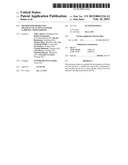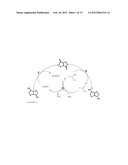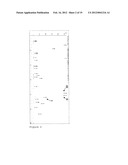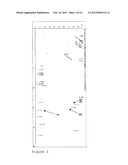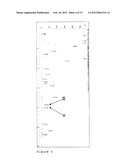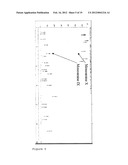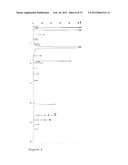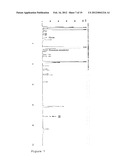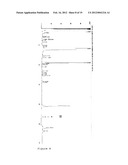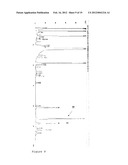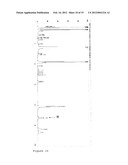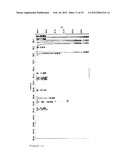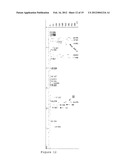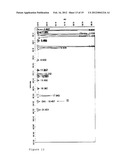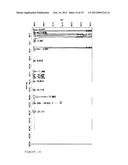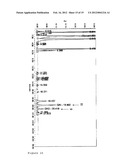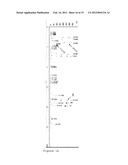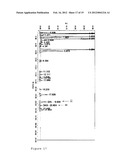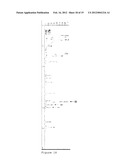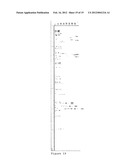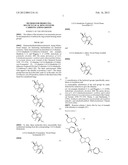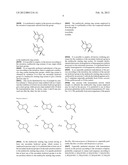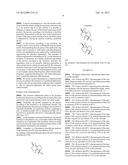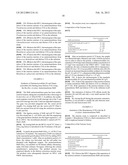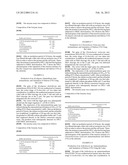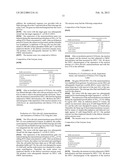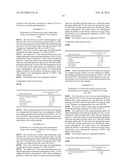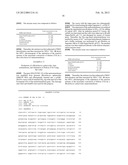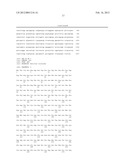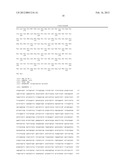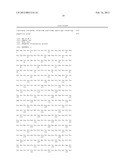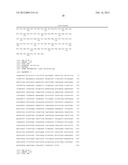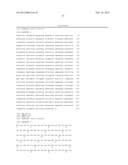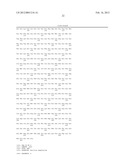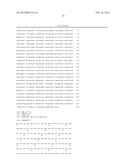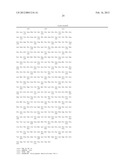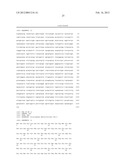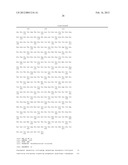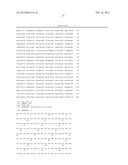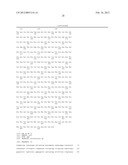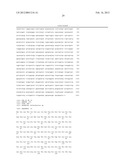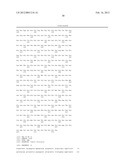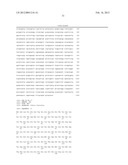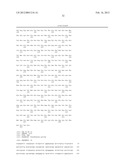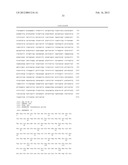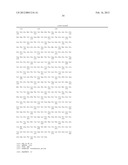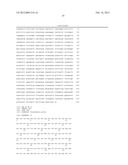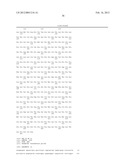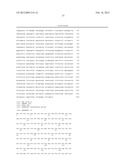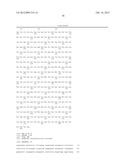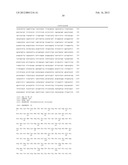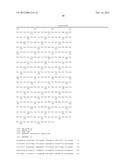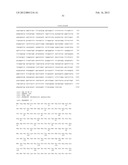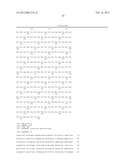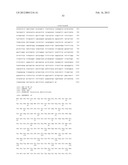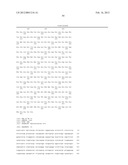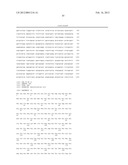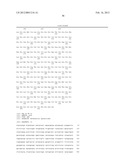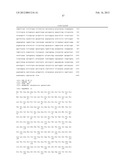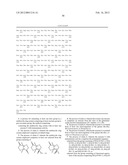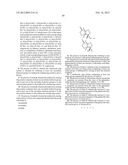Patent application title: METHOD FOR PRODUCING MULTICYCLICAL RING SYSTEMS CARRYING AMINO GROUPS
Inventors:
Volker Sieber (Nandlstadt, DE)
Katrin Grammann (Oer-Erkenschwick, DE)
Broder Ruehmann (Straubing, DE)
Thomas Haas (Muenster, DE)
Thomas Haas (Muenster, DE)
Jan Christoph Pfeffer (Essen, DE)
Kai Doderer (Rodgau, DE)
Claudia Rollmann (Alzenau, DE)
Arne Skerra (Freising, DE)
Christian Rausch (Windsbach, DE)
Alexandra Lerchner (Freising, DE)
Assignees:
EVONIK DEGUSSA GMBH
IPC8 Class: AC07D49304FI
USPC Class:
549464
Class name: Polycyclo ring system having the hetero ring as one of the cyclos bicyclo ring system having the hetero ring as one of the cyclos plural ring oxygens in the bicyclo ring system
Publication date: 2012-02-16
Patent application number: 20120041216
Abstract:
The invention relates to a method for the amination of at least one keto
group in a multicyclic ring system comprising at least one keto group
into an amino group, using at least one enzyme E having transaminase
activity.Claims:
1. A process for aminating at least one keto group in a multicyclic ring
system comprising at least one keto group to give an amino group, the
method comprising: contacting the multicyclic ring system with at least
one enzyme E with transaminase activity.
2. The process of claim 1, wherein the multicyclic ring system employed comprises cis-linked rings.
3. The process of claim 1, wherein the multicyclic ring system employed comprises at least one selected from the group consisting of ##STR00012##
4. The process of claim 1, wherein the at least one enzyme E comprises an enzyme from the class of the glutamine-scyllo-inositol transaminases (EC number: 2.6.1.50).
5. The process of claim 1, wherein the enzyme E is isolated from at least one microorganism of the genera Bacillus, Micromonospora, or Streptomyces.
6. The process of claim 1, wherein the enzyme E is isolated from at least one microorganism of the genera Bacillus circulars or Streptomyces griseus.
7. The process of claim 1, wherein the enzyme E with transaminase activity comprises the polypeptide sequence selected from the group consisting of SEQ ID NO: 2, SEQ ID NO: 4, SEQ ID NO: 7, SEQ ID NO: 9, SEQ ID NO: 11, SEQ ID NO: 13, SEQ ID NO: 15, SEQ ID NO: 17, SEQ ID NO: 19, SEQ ID NO: 21, SEQ ID NO: 23, SEQ ID NO: 25, SEQ ID NO: 27, SEQ ID NO: 29, SEQ ID NO: 31 and SEQ ID NO: 33, or selected from the group consisting of functional equivalents of the enzyme comprising SEQ ID NO: 2, SEQ ID NO: 4, SEQ ID NO: 7, SEQ ID NO: 9, SEQ ID NO: 11, SEQ ID NO: 13, SEQ ID NO: 15, SEQ ID NO: 17, SEQ ID NO: 19, SEQ ID NO: 21, SEQ ID NO: 23, SEQ ID NO: 25, SEQ ID NO: 27, SEQ ID NO: 29, SEQ ID NO: 31, or SEQ ID NO: 33, wherein up to 25% of the amino acid residues have been modified over the corresponding SEQ ID NO: 2, SEQ ID NO: 4, SEQ ID NO: 7, SEQ ID NO: 9, SEQ ID NO: 11, SEQ ID NO: 13, SEQ ID NO: 15, SEQ ID NO: 17, SEQ ID NO: 19, SEQ ID NO: 21, SEQ ID NO: 23, SEQ ID NO: 25, SEQ ID NO: 27, SEQ ID NO: 29, SEQ ID NO: 31, and SEQ ID NO: 33, respectively, by deletion, insertion, substitution, insertion or a combination of deletion, substitution and insertion and which retain at least 50% of the enzymatic activity of the corresponding enzyme of SEQ ID NO: 2, SEQ ID NO: 4, SEQ ID NO: 7, SEQ ID NO: 9, SEQ ID NO: 11, SEQ ID NO: 13, SEQ ID NO: 15, SEQ ID NO: 17, SEQ ID NO: 19, SEQ ID NO: 21, SEQ ID NO: 23, SEQ ID NO: 25, SEQ ID NO: 27, SEQ ID NO: 29, SEQ ID NO: 31, and SEQ ID NO: 33, respectively.
8. The process of claim 1, wherein the multicyclic ring system is obtained by oxidizing at least one secondary hydroxyl group of a multicyclic starting ring system to give a ketone.
9. The process of claim 8, wherein the multicyclic starting ring system comprises at least one secondary hydroxyl group, and at least one of the secondary hydroxyl groups is in the endo-position relative to the multicyclic starting ring system.
10. The process of claim 8, wherein the multicyclic starting ring system comprises least one secondary hydroxyl group, and at least one of the secondary hydroxyl groups is in the exo-position relative to the multicyclic starting ring system.
11. The process of claim 8, wherein the multicyclic starting ring system is at least one compound selected from the group consisting of: isomannide; isosorbide; isoidide; ##STR00013##
12. The process of claim 8, wherein the oxidizing is catalyzed by an enzyme F with alcohol dehydrogenase activity.
13. The process of claim 12, wherein at least one byproduct generated by enzymatic reactions of the enzymes E and F are regenerated by at least one enzyme G with amino acid dehydrogenase activity.
14. The process of claim 1, wherein a ratio of enantiomers formed, of at least one ring system comprising at least one amino group, is influenced by varying at least one reaction condition.
15. A multicyclic ring system comprising at least one amino group, prepared by the process of claim 1.
16. The process of claim 2, wherein the at least one enzyme E comprises an enzyme from the class of the glutamine-scyllo-inositol transaminases (EC number: 2.6.1.50).
17. The process of claim 7, wherein the at least one enzyme E comprises an enzyme from the class of the glutamine-scyllo-inositol transaminases (EC number: 2.6.1.50).
18. The process of claim 2, wherein the enzyme E is isolated from at least one microorganism of the genera Bacillus, Micromonospora, or Streptomyces.
19. The process of claim 3, wherein the enzyme E is isolated from at least one microorganism of the genera Bacillus, Micromonospora, or Streptomyces.
20. The process of claim 4, wherein the enzyme E is isolated from at least one microorganism of the genera Bacillus, Micromonospora, or Streptomyces.
Description:
SUBJECT OF THE INVENTION
[0001] The subject of the invention is an enzymatic process for the preparation of multicyclic ring systems bearing amino groups.
PRIOR ART
[0002] Diaminodianhydrodidesoxyhexitols, being bifunctional amines, are interesting intermediates for chemical reactions. Three stereoisomers are described of 2,5-diamino-1,4:3,6-dianhydro-2,5-didesoxy-D-hexitol (for example Bashford, V. G. and Wiggins, L. F. (1950). Anhydrides of polyhydric alcohols. XIII. The amino derivatives of 1,4:3, 6-dianhydromannitol, -sorbitol, and L-iditol and their behavior towards nitrous acid. Journal of the Chemical Society 1950 371-374): 2,5-diamino-1,4:3,6-dianhydro-2,5-didesoxy-D-mannitol (I), 2,5-diamino-1,4:3,6-dianhydro-2,5-didesoxy-D-glucitol (II) and 2,5-diamino-1,4:3,6-dianhydro-2,5-didesoxy-L-iditol (III). The three stereoisomers differ with regard to the chirality at positions 2 and 5. The amino groups here may be in the endo, endo (I), in the endo, exo (II) or in the exo, exo (III) position, relative to the chair form of the fused five-membered rings.
##STR00001##
[0003] To date, these molecules have successfully been synthesized starting from the corresponding 1:4,3:6-dianhydrohexitols
1,4:3,6-dianhydro-D-mannitol, Trivial Name Isomannide (IV)
##STR00002##
[0004] 1,4:3,6-dianhydro-D-glucitol, Trivial Name Isosorbide (V)
##STR00003##
[0005] and
1,4:3,6-dianhydro-L-iditol, Trivial Name Isoidide (VI)
##STR00004##
[0006] via 1.) esterification of the hydroxyl groups (specifically, mesylation or tosylation) and 2.) nucleophilic substitution of the acid groups by azide, followed by reduction to give the diamine. (cf., for example, Bashford, V. G. and Wiggins, L. F. (1950). Anhydrides of polyhydric alcohols. XIII. The amino derivatives of 1, 4:3, 6-dianhydromannitol, -sorbitol, and L-iditol and their behavior towards nitrous acid Journal of the Chemical Society 1950 371-374; Thiem, J. and Bachmann, F. (1991). Synthesis and properties of polyamides derived from anhydro- and dianhydroalditols Makromolekulare Chemie 192 2163-2182).
[0007] Reaction scheme 1 shows this by way of example with reference to example (IV).
##STR00005##
[0008] While various modifications of the route shown were tested, they have all been without success:
A) The substitution was not carried out with azide, but directly with ammonia (Montgomery, R. and Wiggins, L. F. (1946). Anhydrides of polyhydric alcohols. V. 2,5-Diamino-1,4,3,6-dianhydromannitol and -sorbitol and their sulfanilamide derivatives Journal of the Chemical Society 1946 393-396; Klessing, U.S. Pat. No. 4,535,158; Klessing, DE3028288). This only allowed very low diamine yields to be obtained. B) Primary amines were used for the substitution instead of azide. Again, the yields were low, and, moreover, only alkylated variants of the diamines were synthesized (Hayashi, H.; Ueno, H.; Suzuki, F. (1992) Synthesis of stereoisomers of 1,4:3,6-dianhydrohexitol nitrate derivative, KF-14124. Bioorganic & Medicinal Chemistry Letters, 2(10), 1187-92; Klessing, U.S. Pat. No. 4,535,158; Klessing, DE3028288). C) As an alternative to the reduction, the diazide was reacted with ketones to give the imine, which was subsequently reduced (De Coster, G., Vandyck K., Van der Eycken, E., Van der Eycken, J. Elseviers, M. and Roper, H. (2002) D-Isomannide in synthesis: asymmetric Diels-Alder reactions with novel homochiral bis-imine Cu2+-catalysts. Tetrahedron: Asymmetry 13 (2002) 1673-1679). Again, however, only alkylated variants of the diamines were obtained.
[0009] All these routes start with the stereoisomerically pure anhydrohexitols (IV to VI), which show different reactivities in the individual reaction steps, and lead to stereoisomerically pure products (I-III). Here, the azide route results in an inversion of stereochemistry, for example the endo, endo-diol (IV) becomes the exo, exo-diamine (III) (Cope, A. C. and Shen, T. Y. (1956). Stereochemistry of 1,4:3,6-dianhydrohexitol derivatives Journal of the American Chemical Society 78, 3177-3182), so that, in the terminology used here, 1,4:3,6-dianhydro-D-mannitol (IV), for example, must be used as the starting material for synthesizing 2,5-diamino-1,4:3,6-dianhydro-2,5-didesoxy-L-iditol (III).
[0010] The reaction pathways described have the disadvantage that they are either highly inefficient (substitution of the ditosylate by ammonia, Montgomery, R. and Wiggins, L. F. (1946). Anhydrides of polyhydric alcohols. V. 2,5-Diamino-1,4,3,6-dianhydromannitol and -sorbitol and their sulfanilamide derivatives Journal of the Chemical Society 1946 393-396) or that they are very difficult to perform on an industrial scale, such as, for example, the substitution by azide. Moreover, starting from a pure stereoisomer as the starting material yields only precisely one stereoisomer as the product.
[0011] This is important in as far as only the isosorbide (V) is available in large amounts and at low cost, and, starting from this compound, only product (II) can be synthesized via the route described. However, it would be interesting to be able to synthesize all three amines (I-III) on an industrial scale, starting from this one available starting material (V).
##STR00006##
[0012] The synthesis of the diamines (I) to (III) from diulose (VII) has not been demonstrated to date.
[0013] The only substance where synthesis has been successful was the nitrogen-alkylated derivative of the diamine (I), which has the endo/endo configuration (Limberg, G.; Thiem, J. (1994), Synthetic Approach to N-Alkylated 2,5-Diamino-2,5-didesoxy-1,4;3,6-dianhydroalditols by Reductive Alkylation. Synthesis; 1994 (3) 317-321).
[0014] Various routes, and hence classes of enzymes, for synthesizing amines are found in nature. Examples of these enzymes are transaminases (also referred to as aminotransferases, EC 2.6.1.x), amino acid dehydrogenases (EC 1.4.1.x) and ammonium lyases (EC 4.3.1.x). Here, the typical products of amine formation are α-amino acids, starting from α-ketocarboxylic acids, or α-β-unsaturated carboxylic acids (lyases). In recent times, moreover, so-called amino alcohol dehydrogenases have also been described (U.S. Pat. No. 6,432,688, WO0023608).
[0015] Transaminases are pyridoxal phosphate (PLP)-dependent enzymes which, with formation of an oxo group, transfer amino groups from one molecule to the oxo group of a second molecule, with formation of an amino group. Each transaminase, thus, has at least two substrates: the amino donor (in vivo typically an α-amino acid) and the amino acceptor (see scheme). As a rule, however, transaminases have a very high specificity for these two substrates.
##STR00007##
[0016] If the amino group is located at a chiral center, then the reactions of transaminases will typically preferentially yield one enantiomer. This is why transaminases are frequently used for the chiral resolution of racemic mixtures (for example Matcham, G. W. and Bowen, A. R. S. Biocatalysis for chiral intermediates: Meeting commercial and technical challenges. Chimica Oggi, 1996, 14(6), 20-24. U.S. Pat. No. 6,344,351, EP404146). A specific group of the transaminases are the ω-transaminases, which have the advantage of being able to transfer amino groups to oxo groups which are not activated by adjacent carboxyl groups. Interestingly, however, these enzymes appear to be predominantly (S)-specific (Shin and Kim, 2001, Comparison of the ω-Transaminase from Different Microorganisms and Application to Production of Chiral Amines Biosci. Biotechnol. Biochem. 65 (8): 1782-88).
[0017] There is a great number of transaminases, and a series of substrates and products of transaminases have been described. Thus, it is mainly linear aliphatic ketones and aromatic ketones that have been aminated. A small number of transaminases capable of forming monocyclic aliphatic amines have been described (Lynne A. Lucher, Yu-Ming Chen and James B. Walker (1989) Reactions Catalyzed by Purified L-Glutamine: Keto-Scyllo-Inositol Aminotransferase, an Enzyme Required for Biosynthesis of Aminocyclitol Antibiotics. Antimicrobial Agents and Chemotherapy, 1989, p. 452-459; Bum-Yeol Hwang, Hwa-Jin Lee, Yung-Hun Yang, Hwang-Soo Joo, and Byung-Gee Kim (2004) Characterization and Investigation of Substrate Specificity of the Sugar Aminotransferase WecE from E. coli K12. Chemistry & Biology, Vol. 11, p. 915-925). In contrast, however, the amination of fused multicyclic aliphatic ketones, and in particular of ketones in multicyclic cis-linked aliphatic ring systems, has, however, been unsuccessful as yet.
[0018] It is an object of the invention to provide a process by means of which multicyclic ring systems bearing at least one amino groups can be prepared and which can be used widely. It is a further object of the invention to be able to carry out stereochemistry-independent syntheses regarding starting materials and/or products.
DESCRIPTION OF THE INVENTION
[0019] Surprisingly, it has been found that the enzymatic, transaminase-catalyzed conversion of multicyclic ketone compounds leads to enantiomer mixtures of multicyclic amino compounds.
[0020] This could not have been predicted by a person skilled in the art, and, as specified hereinabove, is entirely unexpected since these enzymatic reactions should, as a rule, be highly stereospecific and enzymes furthermore will, as a rule, be highly substrate-specific.
[0021] Furthermore, it has been found entirely surprisingly that this enantiomer ratio can be influenced by the pH during the reaction.
[0022] In addition it has been found entirely surprisingly that the transaminases accept a very wide range of stereochemical structures of the multicyclic starting materials as substrates. Amines prepared by the process according to the invention are suitable in particular for the preparation of epoxides, polyurethanes or polyamides.
[0023] Subject matter of the present invention, therefore, is a process for the amination of at least one keto group in a multicyclic ring system bearing at least one keto group to give an amino group, using at least one enzyme E with transaminase activity.
[0024] The process according to the invention for the preparation of a multicyclic ring system bearing amino groups is hereinbelow described by way of example, without it being intended to limit the invention to these exemplary embodiments. If ranges, general formulae or classes of compounds are specified hereinbelow, they are intended not only to comprise the ranges or groups of compounds in question which are explicitly mentioned, but also all subranges and subgroups of compounds which can be obtained by taking out individual values (ranges) or compounds. If documents are cited within the scope of the present description, their content shall belong fully to the disclosure content of the present invention. Unless otherwise specified, all percentages (%) indicated are mass percentages.
[0025] A "multicyclic ring system" is understood as meaning substances which are composed of at least two covalently linked ring-shaped molecules.
[0026] A "wild type" of a cell preferably refers to a cell whose genome is present in a state as it has been formed by natural means as the result of evolution. The term is used not only for the entire cell, but also for individual genes. Therefore, the term "wild type" therefore will, in particular, not include those cells or those genes whose gene sequences have at least in part been modified by man by means of recombinant methods.
[0027] The term "overexpression" describes the increase of the intracellular activity or concentration of one or more enzymes or proteins in an organism which are encoded by the relevant DNA, for example by increasing the copy number of the gene(s), of the open reading frame (ORF) or of the ORFS by at least one copy, functionally linking a strong promoter to the gene or using a gene or allele or ORF which codes for a corresponding enzyme or protein with a high activity and, if appropriate, combining these measures. Examples of strong promoters in E. coli which may be mentioned are lac, tac and trp.
[0028] By "transamination" there is meant in general the conversion of a ketone into an amine; in contrast to the conventional use, it is not only alpha-keto acids, but all ketones in general, which are meant to be starting materials.
[0029] "Homologous expression" or "homologous overexpression" is intended to mean the overexpression of a protein which has already previously existed in the microorganism.
[0030] "Heterologous expression" or "heterologous overexpression" is intended to mean the expression or overexpression of a protein which has not previously been present in the microorganism.
[0031] In the process according to the invention, the ring system may be any multicyclic ring system which has at least one keto group. It may be a substance composed of a plurality of substituted or unsubstituted, saturated or unsaturated, aliphatic or aromatic rings; in particular, it takes the form of substances whose rings are linked via a molecular bridge or in which at least one atom is involved in the structure of at least two rings at the same time. The rings may be pure carbon rings or heterocycles or mixtures of the two. The preferred hetero atom in heterocycles is oxygen. Preferred are those rings which exclusively include carbon atoms.
[0032] Suitable preferred substituents on the ring system are short-chain (1 to 5 C atoms) alkyl radicals or alkoxy radicals which are optionally substituted further.
[0033] Multicyclic ring systems which are preferably employed in the process according to the invention are those which include cis-linked rings.
[0034] The number of rings in the ring system is preferably two or three rings. It is especially preferred to employ ring systems having two rings.
[0035] The ring size of an individual ring forming the ring system is preferably 3 to 9, preferably 4 to 7, especially preferably 5 atoms.
[0036] The keto group may be linked to a ring carbon or to a substituent carbon, i.e. to a carbon atom which is not a component of a ring in the ring system.
[0037] In the process according to the invention, the keto group is preferably linked to a ring carbon. Especially preferably, the carbon of the keto group is a component of one of the rings.
[0038] It is preferred to employ in the process according to the invention compounds selected from the group:
##STR00008##
as the multicyclic ring system.
[0039] It is possible to employ, in the process according to the invention, multicyclic ring systems of any origin which bear keto groups.
[0040] In an especially preferred embodiment of the process according to the invention, there is employed a multicyclic ring system bearing keto groups, which ring system is obtained by oxidation of at least one secondary hydroxyl group of a multicyclic starting ring system to give a ketone (process step A).
[0041] This can be illustrated by way of example by reaction scheme 2, where process steps marked with an A represent the oxidation of at least one secondary hydroxyl group to give a keto group, while process steps marked with a B show the transamination step. As shown, steps A and B may proceed one after the other, but also in turns.
##STR00009##
[0042] In the multicyclic starting ring system having at least one secondary hydroxyl group, which system is employed in process step A, it is preferred that at least one of the secondary hydroxyl groups is in the endo-position relative to the multicyclic starting ring system. It is equally preferred that at least one of the secondary hydroxyl groups is in the exo-position relative to the multicyclic starting ring system.
[0043] The multicyclic starting ring system employed in process step A is preferably at least one compound selected from the group:
isomannide, isosorbide, isoidide,
##STR00010##
[0044] It is possible to employ all known oxidizing processes for the oxidation of the secondary hydroxyl group in the multicyclic starting ring system, for example electrochemical processes, homogeneous or heterogeneous catalytic processes or else enzymatic processes. It is preferred here to employ heterogeneous or homogeneous catalysis processes.
[0045] In an especially preferred embodiment of the process according to the invention, the oxidation of the secondary hydroxyl group in the multicyclic starting ring system is catalyzed by an enzyme F with alcohol dehydrogenase activity; F originates especially preferably from Pichia carsonii, Pichia guillermondii or Pichia jadinii.
[0046] Any enzyme with transaminase activity which accepts as substrate the multicyclic ring system employed may be used in the process. It is preferred to use in these processes glutamine-scyllo-inositol transaminases (EC number: 2.6.1.50), preferably from microorganisms of the genera Bacillus, Micromonospora or Streptomyces, especially preferably Bacillus circulans and Streptomyces griseus.
[0047] Especially preferred enzymes with transaminase activity in the process according to the invention comprise, preferably composed of, amino acid sequence according to SEQ ID NO: 2, SEQ ID NO: 4, SEQ ID NO: 7, SEQ ID NO: 9, SEQ ID NO: 11, SEQ ID NO: 13, SEQ ID NO: 15, SEQ ID NO: 17, SEQ ID NO: 19, SEQ ID NO: 21, SEQ ID NO: 23, SEQ ID NO: 25, SEQ ID NO: 27, SEQ ID NO: 29, SEQ ID NO: 31 and SEQ ID NO: 33.
[0048] In a further especially preferred embodiment of the process, the enzyme with transaminase activity is selected from the group of the functional equivalents of the group composed of functional equivalents of the enzymes selected from among the group composed of the enzymes comprising, preferably composed of, SEQ ID NO: 2, SEQ ID NO: 4, SEQ ID NO: 7, SEQ ID NO: 9, SEQ ID NO: 11, SEQ ID NO: 13, SEQ ID NO: 15, SEQ ID NO: 17, SEQ ID NO: 19, SEQ ID NO: 21, SEQ ID NO: 23, SEQ ID NO: 25, SEQ ID NO: 27, SEQ ID NO: 29, SEQ ID NO: 31 and SEQ ID NO: 33, where up to 25%, preferably up to 20%, especially preferably up to 15%, in particular up to 10, 9, 8, 7, 6, 5, 4, 3, 2, 1% of the amino acid residues have been modified by deletion, substitution, an insertion or a combination of deletion, substitution and insertion, over the corresponding SEQ ID NO: 2, SEQ ID NO: 4, SEQ ID NO: 7, SEQ ID NO: 9, SEQ ID NO: 11, SEQ ID NO: 13, SEQ ID NO: 15, SEQ ID NO: 17, SEQ ID NO: 19, SEQ ID NO: 21, SEQ ID NO: 23, SEQ ID NO: 25, SEQ ID NO: 27, SEQ ID NO: 29, SEQ ID NO: 31 and SEQ ID NO: 33, respectively, where the functional equivalents retain at least 50%, preferably 65%, especially preferably 80%, in particular more than 90%, of the enzymatic activity of the enzyme comprising, preferably composed of, SEQ ID NO: 2, SEQ ID NO: 4, SEQ ID NO: 7, SEQ ID NO: 9, SEQ ID NO: 11, SEQ ID NO: 13, SEQ ID NO: 15, SEQ ID NO: 17, SEQ ID NO: 19, SEQ ID NO: 21, SEQ ID NO: 23, SEQ ID NO: 25, SEQ ID NO: 27, SEQ ID NO: 29, SEQ ID NO: 31 and SEQ ID NO: 33, respectively. In this context, enzymatic activity of SEQ ID NO: 2, SEQ ID NO: 4, SEQ ID NO: 7, SEQ ID NO: 9, SEQ ID NO: 11, SEQ ID NO: 13, SEQ ID NO: 15, SEQ ID NO: 17, SEQ ID NO: 19, SEQ ID NO: 21, SEQ ID NO: 23, SEQ ID NO: 25, SEQ ID NO: 27, SEQ ID NO: 29, SEQ ID NO: 31 and SEQ ID NO: 33, respectively, is understood as meaning the ability of transaminating diulose (VII) to give the corresponding diamines diaminoisosorbide (II) and diaminoisoidide (III). Enzymes with transaminase activity E which can be employed in the process according to the invention are also "functional equivalents" or "functional derivatives". "Functional equivalents" or analogs of the specifically disclosed enzymes are, within the scope of the present invention, polypeptides which differ from the above but which still have the desired biological activity, such as, for example, substrate specificity. Thus, for example, "functional equivalents" are understood as meaning enzymes which transanimate diulose (VII) to give the corresponding diamines and which have at least 50%, preferably 60%, especially preferably 75%, very especially preferably 90% of the activity of an enzyme with the amino acid sequence mentioned in SEQ ID NO: 2, SEQ ID NO: 4, SEQ ID NO: 7, SEQ ID NO: 9, SEQ ID NO: 11, SEQ ID NO: 13, SEQ ID NO: 15, SEQ ID NO: 17, SEQ ID NO: 19, SEQ ID NO: 21, SEQ ID NO: 23, SEQ ID NO: 25, SEQ ID NO: 27, SEQ ID NO: 29, SEQ ID NO: 31 and SEQ ID NO: 33, respectively. Moreover, enzyme E and its functional equivalents are preferably stable between pH 4 to 10 and advantageously have a pH activity optimum at between pH 5 and 8 and a temperature activity optimum in the range of from 20° C. to 80° C.
[0049] "Functional equivalents" may in particular also be understood as meaning mutants which include in at least one sequence position of the abovementioned amino acid sequences an amino acid which is other than the specifically mentioned amino acid, but which mutants still retain one of the abovementioned biological activities. Therefore, "functional equivalents" comprise the mutants obtainable by one or more amino acid additions, substitutions, deletions and/or inversions, it being possible for the abovementioned modifications to occur in any sequence position as long as they lead to a mutant with the property profile according to the invention. Functional equivalence exists in particular also when the reactivity patterns between mutant and unmodified polypeptide agree in terms of quality, i.e. when, for example, identical substrates are converted at different rates.
[0050] Examples of suitable amino acid substitutions can be gleaned from the following table:
TABLE-US-00001 Original residue Substitution examples Ala Ser Arg Lys Asn Gln; His Asp Glu Cys Ser Gln Asn Glu Asp Gly Pro His Asn; Gln Ile Leu; Val Leu Met; Val Lys Arg; Gln; Glu Met Leu; Ile Phe Met; Leu; Tyr Ser Thr Thr Ser Trp Tyr Tyr Trp; Phe Val Ile; Leu
[0051] "Functional equivalents" may, according to the invention, also be understood as meaning in particular mutants which include in at least one sequence position of the abovementioned amino acid sequences an amino acid other than the specifically mentioned amino acid, but which mutants still retain one of the abovementioned biological activities. Therefore, "functional equivalents" also preferably comprise the mutants obtainable by one or more amino acid additions, substitutions, deletions and/or inversions, it being possible for the above-mentioned modifications to occur in any sequence position as long as they lead to a mutant with the property profile according to the invention. Functional equivalence exists in particular also when the reactivity patterns between mutant and unmodified polypeptide agree in terms of quality, i.e. when, for example, identical substrates are converted at different rates.
[0052] "Functional equivalents" in the above sense may also be "precursors" of the described polypeptides, and "functional derivatives" and "salts" of the polypeptides. "Precursors" may be natural or synthetic precursors of the polypeptides with or without the desired biological activity. The term "salts" is understood as meaning not only salts of carboxyl groups, but also acid addition salts of amino groups of the protein molecules according to the invention. Salts of carboxyl groups can be prepared in a manner known per se and comprise inorganic salts, such as, for example, sodium salts, calcium salts, ammonium salts, iron salts and zinc salts, and salts with organic bases, such as, for example, amines, such as triethanolamine, arginine, lysine, piperidine and the like. Acid addition salts such as, for example, salts with mineral acids, such as hydrochloric acid or sulfuric acid, and salts with organic acids, such as acetic acid and oxalic acid, are likewise subject matter of the invention.
[0053] "Functional derivatives" of polypeptides according to the invention can be prepared on functional amino acid side groups or on their N- or C-terminal ends, using known techniques. Such derivatives comprise, for example, aliphatic esters of carboxylic acid groups, amides of carboxylic acid groups, obtainable by reaction with ammonia or with a primary or secondary amine, N-acyl derivatives of free amino groups, obtained by reaction with acyl groups, or O-acyl derivatives of free hydroxyl groups, obtained by reaction with acyl groups. Naturally, "functional equivalents" may also be polypeptides which can be obtained from other organisms, and naturally occurring variants. For example, ranges of homologous sequence regions can be determined by sequence comparison, and equivalent enzymes can be found by referring to the specific requirements of the invention.
[0054] "Functional equivalents" likewise comprise fragments, preferably individual domains or sequence motives, of the polypeptides according to the invention which have for example the desired biological function.
[0055] "Functional equivalents" may, moreover, be fusion proteins which include one of the abovementioned polypeptide sequences or functional equivalents derived therefrom and at least one further, functionally different, heterologous sequence in functional N- or C-terminal linkage (i.e. without the fusion protein moieties mutually adversely affecting each other functionally to a substantial degree). Nonlimiting examples of such heterologous sequences are, for example, signal peptides or enzymes.
[0056] According to the invention, "functional equivalents" may be homologs to the specifically disclosed enzymes. The homologs have at least 60%, preferably at least 75%, in particular at least 85%, such as, for example, 90%, 95% or 99%, homology to one of the specifically disclosed amino acid sequences, calculated by the algorithm of Pearson and Lipman (Pearson W R, Lipman D J. Improved tools for biological sequence comparison. Proc Natl Acad Sci USA. 1988 April; 85(8):2444-8). A percentage homology of a homologous polypeptide according to the invention means in particular the percentage identity of the amino acid residues based on the total length of one of the amino acid sequences described specifically herein.
[0057] In the event of protein glycosylation, which is possible, "functional equivalents" according to the invention comprise enzymes of the above-specified type in deglycosylated or glycosylated form, and modified forms obtainable by altering the glycosylation pattern.
[0058] Homologs of the enzymes according to the invention can be generated by mutagenesis, for example by point mutation or by truncating the enzyme.
[0059] Homologs of the enzyme according to the invention can be identified by screening combinatorial libraries of mutants, such as, for example, truncation mutants. For example, such a library of protein variants can be generated by combinatorial mutagenesis at the nucleic acid level such as, for example, by enzymatically ligating a mixture of synthetic oligonucleotides. A multiplicity of processes exist which can be used for generating libraries of potential homologs, starting with a degenerate oligonucleotide sequence. The chemical synthesis of a degenerate gene sequence may be performed in an automatic DNA synthesizer, and the synthetic gene may then be ligated into a suitable expression vector. The use of a set of degenerate genes makes it possible to provide a mixture of all sequences which code for the desired set of potential protein sequences. Processes for the synthesis of degenerate oligonucleotides are known to a person skilled in the art (for example Ike Y, Ikuta S, Sato M, Huang T, Itakura K. Solid phase synthesis of polynucleotides. VIII. Synthesis of mixed oligodeoxyribonucleotides by the phosphotriester solid phase method. Nucleic Acids Res. 1983 Jan. 25; 11(2):477-88). The prior art knows a plurality of techniques for screening gene products of combinatorial libraries which have been generated by point mutations or by truncation, and for screening cDNA libraries for gene products with a selected property. These techniques can be adapted to the rapid screening of the gene libraries which have been generated by combinatorial mutagenesis of homologs according to the invention. The most frequently used techniques for screening large gene libraries which are subjected to high-throughput analysis comprise cloning the gene library into replicating expression vectors, transforming the suitable cells with the resulting vector library and expressing the combinatorial genes under conditions under which the detection of the desired activity simplifies the isolation of the vector which codes for the gene whose product has been detected. Recursive ensemble mutagenesis (REM), a technique which increases the frequency of functional mutants in the libraries, may, in combination with the screening tests, be used to identify homologs (Arkin A P, Youvan D C. An algorithm for protein engineering: simulations of recursive ensemble mutagenesis. Proc. Natl. Acad. Sci. USA. 1992 Aug. 15; 89(16):7811-5).
[0060] The enzymes employed in the process according to the invention can be prepared by the methods known to a person skilled in the art, which include, for example, the production in cell cultures or in microorganisms, or in-vitro translation. These methods require in particular nucleic acid sequences (single- and double-stranded DNA and RNA sequences such as, for example, cDNA and mRNA).
[0061] Subject matter of the invention is the use of the nucleic acid sequences which code for an enzyme with transaminase activity according to the invention or for one of its functional equivalents. Preferred are nucleic acid sequences which code for the amino acid sequence according to SEQ ID NO: 2, SEQ ID NO: 4, SEQ ID NO: 7, SEQ ID NO: 9, SEQ ID NO: 11, SEQ ID NO: 13, SEQ ID NO: 15, SEQ ID NO: 17, SEQ ID NO: 19, SEQ ID NO: 21, SEQ ID NO: 23, SEQ ID NO: 25, SEQ ID NO: 27, SEQ ID NO: 29, SEQ ID NO: 31 and SEQ ID NO: 33 or characteristic part-sequences thereof. The nucleic acids in question can be determined readily by backtranslating SEQ ID NO: 2, SEQ ID NO: 4, SEQ ID NO: 7, SEQ ID NO: 9, SEQ ID NO: 11, SEQ ID NO: 13, SEQ ID NO: 15, SEQ ID NO: 17, SEQ ID NO: 19, SEQ ID NO: 21, SEQ ID NO: 23, SEQ ID NO: 25, SEQ ID NO: 27, SEQ ID NO: 29, SEQ ID NO: 31 and SEQ ID NO: 33 according to the genetic code. Here, what is known as codon optimization, in other words the adaptation of the codons to the frequently used codons of particularly highly expressed genes of the envisaged host organism in which the nucleic acid is intended to be expressed. Nucleic acid sequences can be prepared by chemical synthesis from the nucleotide units, such as, for example, by fragment condensation of individual overlapping complementary nucleic acid units. The chemical synthesis of oligonucleotides can be performed for example by the phosphoamidite method (Koster H, Blocker H, Frank R, Geussenhainer S, Kaiser W. Total synthesis of a structural gene for the human peptide hormone angiotensin II. Hoppe Seylers Z Physiol Chem. 1975 October; 356(10):1585-93). It is also possible to employ nucleic acid sequences which code for one of the above polypeptides and their functional equivalents, which are available for example using artificial nucleotide analogs, in the process according to the invention.
[0062] Likewise, it is possible to employ nucleic acids which hybridize with abovementioned coding sequences under stringent conditions. This characteristic is understood as meaning the ability of a poly- or oligonucleotide to bind under stringent conditions to a virtually complementary sequence, while unspecific binding between noncomplementary partners fails to materialize under these conditions. To this end, the sequences should have a complementarity of 70-100%, preferably 90-100%. The property of complementary sequences of being able to bind specifically with each other is exploited for example in the screening of genomic libraries or cDNA libraries, in the Northern or Southern blot technique or in the binding of primers in the PCR or RT-PCR. Usually, one employs oligonucleotides of a length of 30 base pairs or longer. Stringent conditions, for example in the Northern blot technique, are understood as meaning the use of a wash solution with a temperature of 50-70° C., preferably 60-65° C., for example 0.1×SSC buffer containing 0.1% SDS (20×SSC: 3M NaCl, 0.3M Na citrate, pH 7.0) for eluting unspecifically hybridized cDNA probes or oligonucleotides. During this process, only highly complementary nucleic acids remain bound to each other, as has been mentioned above. The setting of stringent conditions is known to a person skilled in the art and described, for example, in Ausubel et al., Current Protocols in Molecular Biology, John Wiley & Sons, N.Y. (1989), 6.3.1-6.3.6. If appropriate, such polynucleotides can be multiplied by means of PCR, using suitable primers, and subsequently isolated. Moreover, such polynucleotides may also be synthesized chemically.
[0063] It is especially preferred to use a nucleic acid sequence comprising SEQ ID NO: 1 to provide the enzyme E in the process according to the invention.
[0064] The invention furthermore relates to expression constructs, comprising, under the genetic control of regulatory nucleic acid sequences, a nucleic acid sequence which codes for a polypeptide according to the invention, and to vectors, comprising at least one of these expression constructs.
[0065] Preferably, such constructs according to the invention comprise a promoter 5'-upstream of the respective coding sequence, and, 3'-downstream, a terminator sequence and, if appropriate, further customary regulatory elements, in each case in operable linkage with the coding sequence.
[0066] An "operable linkage" is understood as meaning the sequential arrangement of promoter, coding sequence, terminator and, if appropriate, further regulatory elements in such a way that each of the regulatory elements can fulfil its intended function upon expression of the coding sequence. Examples of operably linkable sequences are targeting sequences, and also enhancers, polyadenylation signals and the like. Further regulatory elements comprise selectable markers, amplification signals, replication origins and the like. Examples of suitable regulatory sequences are described in Goeddel, Gene Expression Technology: Methods in Enzymology 185, Academic Press, San Diego, Calif. (1990).
[0067] A nucleic acid construct according to the invention is understood as meaning in particular those in which the gene for a transaminase according to the invention have been operably or functionally linked to one or more regulatory signals for regulating, for example increasing, gene expression.
[0068] A preferred nucleic acid construct advantageously also comprises one or more of the already-mentioned "enhancer" sequences, in functional linkage with the promoter, which sequences make possible an enhanced expression of the nucleic acid sequence. It is also possible to insert additional advantageous sequences at the 3' end of the DNA sequences, such as further regulatory elements or terminators. One or more copies of the nucleic acids according to the invention may be present in the construct. Further markers, such as genes complementing antibiotic resistances or auxotrophisms, may also be present in the construct, if appropriate in order to select for the construct. For expression in a host organism, the nucleic acid construct is advantageously inserted into a vector such as, for example, a plasmid or a phage, which vector makes possible the optimal expression of the genes in the host. Apart from plasmids and phages, vectors are also understood as meaning all the other vectors with which the person skilled in the art is familiar, that is, for example, viruses such as SV40, CMV, baculovirus and adenovirus, and linear or circular DNA. These vectors can be replicated autonomously in the host organism or else they can be replicated chromosomally. Further vectors and plasmids are known to a person skilled in the art and can be found for example in the book Cloning Vectors, A laboratory Manual (Eds. Pouwels P. H. et al. Elsevier, Amsterdam-N.Y.-Oxford, 1985). In a further embodiment of the vector, the vector comprising the nucleic acid construct according to the invention or the nucleic acid according to the invention can advantageously also be introduced into the microorganisms in the form of a linear DNA and integrated into the genome of the host organism via heterologous or homologous recombination. This linear DNA can consist of a linearized vector such as a plasmid or else only of the nucleic acid construct or the nucleic acid according to the invention.
[0069] It is preferred to produce the enzymes used in the process according to the invention in microorganisms. Microorganisms are, as a rule, grown in a liquid medium which contains a carbon source, in most cases in the form of sugars, a nitrogen source, in most cases in the form of organic nitrogen sources such as yeast extract or salts such as ammonium sulfate, trace elements such as iron salts, manganese salts, magnesium salts and, if appropriate, vitamins, at temperatures of between 0° C. and 100° C., preferably between 10° C. to 60° C., while passing in oxygen. During this process, the pH of the liquid medium can be maintained at a fixed value, that is can be regulated during culturing or not. Culturing can be carried out batchwise, semi-batchwise or continuously. Nutrients can be provided at the beginning of the fermentation or fed in semicontinuously or continuously.
[0070] The enzymes can be purified with the aid of known chromatographic methods. These include, for example, gel filtration, anion and cation exchange chromatography and hydrophobic interaction chromatography. Other customary methods such as ultrafiltration, crystallization, salting out, dialysis and native gel electrophoresis may also be employed. Further suitable methods are described, for example, in Cooper, F. G., Biochemische Arbeitsmethoden, Verlag Walter de Gruyter, Berlin, N.Y. To isolate the recombinant protein, it may be advantageous to use vector systems or oligonucleotides which extend the cDNA by certain nucleotide sequences and thus code for modified polypeptides or fusion proteins which serve the purpose of, for example, simplifying purification. Such suitable modifications are, for example, so-called "tags", which act as anchors and which can frequently also be recognized by antibodies as antigens such as, for example, His tags, Strep tags, myc tags, Flag tags, MBP tags and GST tags. These anchors can serve the purpose of attaching the proteins to a solid support such as, for example, a polymer matrix which, for example, can be packed into a chromatography column, or to a microtiter plate or to any other support.
[0071] In a preferred embodiment, the process according to the invention is carried out in the presence of the organisms required for the production of the enzymes E and/or F, i.e. the transamination on the multicyclic ring system and/or, if appropriate, the oxidation on the starting ring system may take place during the culturing and growth of the organisms which produce E and/or F. The starting material may be added directly to the cultivation or after the cultivation.
[0072] The organism employed for the production of the enzymes used in the process according to the invention may be immobilized or else freely mobile in the culture. This organism employed may be a prokaryote or a eukaryote. It may take the form of mammalian cells (such as, for example, human cells), plant cells or microorganisms such as yeasts, fungi or bacteria. It is preferred to employ a microorganism as the organism in the process according to the invention.
[0073] It is especially preferred to employ, in the process according to the invention, an organism which is selected from the group:
at least one member of the genus Bacillus, at least one member of the genus Lactobacillus, at least one member of the genus Pseudomonas, at least one member of the genus Streptococcus, at least one member of the genus Streptomyces, at least one member of the genus Hansenula, at least one member of the genus Pichia, at least one member of the genus Aspergillus, at least one member of the genus Escherichia and/or at least one member of the genus Saccharomyces.
[0074] It is advantageous to employ Gram-positive or Gram-negative bacteria, preferably bacteria from the families Enterobacteriaceae, Pseudomonadaceae, Rhizobiaceae, Streptomycetaceae or Nocardiaceae, especially preferably bacteria of the genera Escherichia, Corynebacteria, Pseudomonas, Streptomyces, Nocardia, Burkholderia, Salmonella, Agrobacterium or Rhodococcus. The species Escherichia coli or Corynebacterium glutamicum are very especially preferred. Further advantageous bacteria can furthermore be found in the group of the Gram-positive, alpha-Proteobacteria, beta-Proteobacteria or gamma-Proteobacteria, and further advantageous microorganisms in the genus Saccharomyces.
[0075] In the process according to the invention, the enzymes E and F can be expressed separately from each other in at least two different organisms. The simultaneous expression of the enzymes E and F in one organism is preferred.
[0076] The organism may already naturally express, as the wild type, the enzyme employed in the process according to the invention. It may be advantageous to increase the activity of the employed enzyme E and/or F in the organism. This can be achieved for example by overexpressing the enzyme by known or above-described recombinant DNA techniques, but, for example, also by mutagenesis, followed by screening methods of the organisms for increased activity.
[0077] It is possible to employ, in the process according to the invention, an organism which, as the wild type, does not express any enzyme to be employed, but which, with the aid of recombinant techniques, has been made capable of heterologously expressing a suitable enzyme.
[0078] In the process according to the invention, the expressed enzyme is preferably overexpressed homologously, the expressed enzyme is especially preferably overexpressed heterologously. This can be done with the aid of an expression cassette in which a suitable promoter has been fused to a suitable coding nucleotide sequence and to a terminator or polyadenylation signal. To this end, one employs customary recombination and cloning techniques as they are described for example in T. Maniatis, E. F. Fritsch and J. Sambrook, Molecular Cloning: A Laboratory Manual, Cold Spring Harbor Laboratory, Cold Spring Harbor, N.Y. (1989) and in T J. Silhavy, M. L. Berman and L. W. Enquist, Experiments with Gene Fusions, Cold Spring Harbor Laboratory, Cold Spring Harbor, N.Y. (1984) and in Ausubel, F. M. et al., Current Protocols in Molecular Biology, Greene Publishing Assoc. and Wiley Interscience (1987). For expression, the recombinant nucleic acid construct or gene construct is inserted into a suitable host organism, advantageously into a host-specific vector, which makes possible the optimal expression of the genes in the host. Vectors are well known to a person skilled in the art and can be found for example in "Cloning Vectors" (Pouwels P. H. et al., Ed., Elsevier, Amsterdam-N.Y.-Oxford, 1985).
[0079] The expressed enzymes which are employed in the process according to the invention can be secreted or else expressed intracellularly by the produced organism.
[0080] In the process according to the invention, the transamination of the keto group and, if appropriate, the preceding oxidation of the hydroxyl group may take place during the culturing of the organism or else after culturing. The organism can be separated from the culture medium or else remain therein. In the case of the intracellular expression of the enzyme employed, it may be advantageous to disrupt the organism cells using methods known to a person skilled in the art, such as, for example, with detergents, a French press or a ball mill.
[0081] Owing to technical advantages of the process, it is preferred for the enzyme E and/or F to exert their catalytic function in the cell and for the process to be carried out continuously in the whole-cell catalyst.
[0082] In a further embodiment of the process according to the invention, the enzyme E and/or F is employed in purified form. Purification may be performed with known, above-described or chromatographic methods.
[0083] In this embodiment of the process according to the invention, the enzyme E and/or F may be present in immobilized form, for example coupled to latex spheres, or else free in solution. The preferred solvent in the process according to the invention is water.
[0084] The process according to the invention is advantageously carried out at a temperature between 0° C. to 95° C., preferably between 10° C. to 85° C., especially preferably between 15° C. to 75° C.
[0085] The pH in the process according to the invention is advantageously maintained at between pH 4 and 12, preferably between pH 5 and 10, especially preferably between pH 6 and 9. The process according to the invention can be carried out batchwise, semi-batchwise or continuously.
[0086] It may be advantageous to vary the reaction conditions, preferably the pH, during the enzymatic amination, that is to say process step B. In this manner, it is possible to influence, or adjust, the ratio of the formed enantiomers in the product. The process according to the invention is therefore preferably characterized in that the ratio of the formed enantiomers of the ring systems bearing at least one amino group is influenced by varying the reaction conditions, preferably the pH.
[0087] In the process according to the invention, the enzyme F and E can be used for oxidizing the hydroxyl group and for transaminating the keto group of the multicyclic ring system, and an enzyme G with amino acid dehydrogenase activity can simultaneously be employed for simultaneously regenerating the reduction equivalents. This principle of cofactor regeneration is illustrated in FIG. 1 with reference to examples of substances. In a further, preferred embodiment of the process according to the invention, therefore, the byproducts, such as, for example, reduction equivalents or amino group donors, which are generated by the enzymatic reactions of enzymes E and F are regenerated by using at least one enzyme G with amino acid dehydrogenase activity, such as, for example, alanine dehydrogenase, phenylalanine dehydrogenase, aspartate dehydrogenase and serine dehydrogenase, in particular glutamate dehydrogenase.
[0088] If a scyllo-inositol transaminases is employed in the process according to the invention, it is preferred additionally to employ the enzymes glutamine synthetase and w-amidase in order to regenerate glutamine, the amino group donor employed here.
Products of the Transamination
[0089] The invention furthermore relates to the products produced by the process according to the invention, that is the multicyclic ring systems bearing at least one amino group.
[0090] Preferably, the product prepared by the process according to the invention is an enantiomer mixture. The product prepared by the process according to the invention is especially preferably an enantiomer mixture comprising a ratio of diaminoisoidide (III) to diaminoisosorbide (II) of from 0.5 to 4, preferably from 0.8 to 3 and especially preferably from 1 to 2.
[0091] In the examples mentioned hereinbelow, the present invention is described by way of example without this being intended to be a limitation of the invention, whose use range can be seen from the entire description and the claims, to the embodiments mentioned in the examples.
[0092] Examples 1 to 3 hereinbelow describe the synthesis of the diamines (II)-(III) from hexodiulose (VII),
the synthesis of the mixed diamines/diols (IX and X) from the monoketone (VIII)
##STR00011##
and the synthesis of the diamines (II)-(III) directly from (V) and (IV).
EXAMPLES
[0093] The figures which follow illustrate the subject matter of the example:
[0094] FIG. 2 shows the HPLC chromatogram of the standards diaminoisoidide (III) (0.5 g/l) and diaminoisosorbide (II) (0.5 g/l) and diaminoisomannitol (I).
[0095] FIG. 3 shows the HPLC chromatogram of the reductive amination with the products diaminoisosorbide, diaminoisoidide and traces of diaminoisomannide at pH 7.2.
[0096] FIG. 4 shows the HPLC chromatogram of the separation of the reaction mixture of aminotransferase BtrR and diulose (VII) as substrate at pH 9.
[0097] FIG. 5 shows the HPLC chromatogram of the separation of the reaction mixture of aminotransferase BtrR and monoketone (VIII) as substrate at pH 9.
[0098] FIG. 6 shows the HPLC chromatogram of the separation of the reaction mixture of an aminotransferase from Vibrio fluvialis and diulose (VII) as the substrate.
[0099] FIG. 7 shows the HPLC chromatogram of the separation of the reaction mixture of an aminotransferase from Bacillus megaterium and diulose (VII) as the substrate.
[0100] FIG. 8 shows the HPLC chromatogram of the separation of the reaction mixture of an aminotransferase from Alcaligenes denitrificans and diulose (VII) as the substrate.
[0101] FIG. 9 shows the HPLC chromatogram of the separation of the reaction mixture of an aminotransferase from Chromobacterium violaceum and diulose (VII) as the substrate.
[0102] FIG. 10 shows the HPLC chromatogram of the separation of the reaction mixture of an aminotransferase from Anthrobacter sp. and diulose (VII) as the substrate.
[0103] FIG. 11 shows the HPLC chromatogram of the separation of the reaction mixture of an aminotransferase from Vibrio fluvialis and diulose (VII) as the substrate.
[0104] FIG. 12 shows the HPLC chromatogram of the separation of the reaction mixture of an aminotransferase from Pseudomonas putida and diulose (VII) as the substrate.
[0105] FIG. 13 shows the HPLC chromatogram of the separation of the reaction mixture of an aminotransferase from Pseudomonas putida and diulose (VII) as the substrate.
[0106] FIG. 14 shows the HPLC chromatogram of the separation of the reaction mixture of an aminotransferase from Pseudomonas putida and diulose (VII) as the substrate.
[0107] FIG. 15 shows the HPLC chromatogram of the separation of the reaction mixture of an aminotransferase from Chromobacterium violaceum and diulose (VII) as the substrate.
[0108] FIG. 16 shows the HPLC chromatogram of the separation of the reaction mixture of an aminotransferase from Rhodobacter sphaeroides and diulose (VII) as the substrate.
[0109] FIG. 17 shows the HPLC chromatogram of the separation of the reaction mixture of an aminotransferase from Paracoccus denitrificans and diulose (VII) as the substrate.
[0110] FIG. 18 shows the HPLC chromatogram of the separation of the reaction mixture of an aminotransferase from Mesorhizobium loti and diulose (VII) as the substrate.
[0111] FIG. 19 shows the HPLC chromatogram of the separation of the reaction mixture of an aminotransferase from Rhodobacter sphaeroides and diulose (VII) as the substrate.
EXAMPLE 1
Synthesis of Diaminoisosorbide (II) and Diaminoisoidide (III) Starting from Diulose (VII) Using the Bacillus circulans Aminotransferase BtrR
[0112] The BtrR aminotransferase gene has been synthesized at Geneart, taking into consideration the codon usage of Escherichia coli, cf. SEQ ID NO: 5. In addition, the synthesized sequence received an EcoRI cleavage site at the 5' end and a PstI cleavage site at the 3' end (see appended sequence). The gene was provided integrated into the vector pGA4 (ampR). For cloning btrR into the vector pACYC-Duet-1, btrR was excised from pGA4 using the restriction enzymes EcoRI and PstI.
[0113] The ligation mixture of btrR and pACYC-Duet-1 was first cloned into E. coli DH5α and, after the sequencing of the gene had been checked, into the target organism E. coli BL21 (DE3). The recombinant plasmid is named pACYC-Duet1::btrR.
[0114] By cloning btrR into the MCS1 of pACYC-Duet1, a (His)6-tag fusion is introduced at the N terminus of the protein.
[0115] To purify the protein BtrR-(His)6, E. coli BL21 was cultured in LB medium. The expression of btrR was induced in the exponential growth phase OD 0.4-0.6 by adding IPTG (final concentration 1 mM). After an incubation period of 6 hours, the culture was harvested, and the cell pellet was disrupted with BugBuster reagent. The aminotransferase BtrR-(His)6 was purified via Ni-chelate affinity chromatography (His-bind columns, Novagen), following the column manufacturer's instructions. The purified enzyme was employed directly in the diulose conversion enzyme assay. The products were subsequently detected via HPLC with FMOC derivatization.
[0116] The enzyme assay was composed as follows:
Composition of the Enzyme Assay
TABLE-US-00002 [0117] Final concentration in the Buffer and solutions mixture 0.1M Tris-HCl buffer pH 9 or pH 7.2 50 mM Diulose 50 mM L-Glutamine 10 mM Pyridoxal phosphate 0.3 mM Purified BtrR in 50 mM Tris-HCl 80 μg Total volume 100 μl
[0118] After an incubation period of 72 hours, the sample was filtered through a filtration unit with a 10 kDa exclusion size in order to remove the protein. A diaminoisoidide concentration of 8.46 mg/l and a diaminosorbide concentration of 6.3 mg/l were measured in the FMOC-HPLC. Under these conditions, the ratio of diaminoisoidide (III) to diaminoisosorbide (II) was 1.34. It was possible to shift the ratio (III):(II) towards an increased diaminoisoidide synthesis by lowering the pH. At a pH of 7.2, a diaminoisoidide:diaminoisosorbide ratio of 1.8 was obtained (2.28 g/l vs. 1.27 g/l).
[0119] FIG. 2 shows the chromatogram of the standards diaminoisoidide (0.5 g/l) and diaminoisosorbide (0.5 g/l).
[0120] FIG. 3 shows the separation of the reaction mixture of amino-transferase BtrR and diulose (VII) as substrate at pH 9, FIG. 4 the separation of the reaction mixture of aminotransferase BtrR and diulose (VII) as the substrate at pH 7.2.
[0121] The amination of diulose (VII) affords mostly the diamines (II) and (III) and only a very small amount of the diamine (I).
[0122] By varying the pH during the enzymatic amination, therefore, it was possible to modify the ratio between stereoisomer (II) and stereoisomer (III).
EXAMPLE 2
Amination of the Monoketone (VIII) with the B. circulans Aminotransferase BtrR
[0123] The enzyme assay is composed as described in example 1. Monoketone (VIII) at a final concentration of 50 mM is employed instead of diulose.
Composition of the Enzyme Assay
TABLE-US-00003 [0124] Final concentration in the Buffer and solutions mixture 0.1M Tris-HCl buffer pH 9 50 mM Monoketone (VIII) 50 mM L-Glutamine 10 mM Pyridoxal phosphate 0.3 mM Purified BtrR in 50 mM Tris-HCl 400 μg Total volume 500 μl
[0125] FIG. 5 shows the HPLC diagram of the separation of the reaction mixture of aminotransferase BtrR and monoketone (VIII) as substrate at pH 9. The amination of the monoketone (VIII) affords more (X) than (IX), analogously to example 1.
EXAMPLE 3
Starting from Isosorbide, Conversion into the Diamine in a Coupled Reaction
[0126] To successfully convert isosorbide into the diamine, a reaction with cell extract from Pichia guillermondii and purified BtrR-His protein is set up. Besides the direct synthesis of isosorbide via diulose to give the diamine, the synthesis also proceeds via the intermediates monoketone-monoalcohol, monoamine-monoalcohol, monoamine-monoketone to give the diamine. The cell extract of P. guillermondii is prepared as follows: 0.43 g of moist cell biomass was resuspended in 1 ml 0.1 mol/l Tris/HCl buffer pH 7.2 in a reaction vessel (fill level 1.5 ml). To this cell suspension there were added 1 g of glass beads (diameter 0.25-0.3 mm), whereupon the cells were disrupted in a ball mill (Retsch) for 2×5 min at a frequency of 1/30 s. Before the second 5-min run, the reaction vessel was briefly placed on ice in order to dissipate frictional heat. The mixture was centrifuged for 10 min at 13200×g and the supernatant was removed carefully. After an incubation period of 72 hours, the samples are centrifuged in a table-top centrifuge using filter units with an exclusion size of 30 kDa. Pyruvate and L-lactate dehydrogenase are employed to avoid a backreaction of the "isosorbide" dehydrogenase and to regenerate NAD.sup.+.
[0127] The enzyme assay is composed as follows:
TABLE-US-00004 Final concentration in the Buffer and solutions mixture 0.1M Tris-HCl buffer pH 8.2 50 mM Pyruvate 20 mM NAD.sup.+ 1 mM L-Lactate dehydrogenase 50 U Isosorbide 10 mM P. guilliermondii enzyme 10% of the final volume extract (100 μl) Pyridoxal phosphate 0.3 mM Purified BtrR in 50 mM Tris-HCl 800 μg Protease inhibitor (Sigma) 10 μl Total volume 1 ml
[0128] Using HPLC analysis, it is possible to identify the monoamine intermediates (IX) and (X) and the diamines (II) and (III). It was possible to oxidize isosorbide (V) and isomannide (IV) up to the diulose (VII) level. Using the recombinantly expressed transaminase, the oxidation product (diulose (VII)) was aminated to give the diamine (II) and (III), and the oxidation intermediates (for example the monoketone (VIII)) were aminated to give the monoamines (IX) and (X).
[0129] Thus, it was possible not only successfully to enzymatically oxidize the secondary hydroxyl groups of dianhydrohexitols both at the exo-position and at the endo-position, but the products of these reactions were also successfully enzymatically aminated. Here, it was possible to obtain amino groups both in exo and in endo position.
EXAMPLE 4
Production of a Vibrio fluvialis Aminotransferase, and Amination of Diulose (VII) Using the Latter
[0130] The Vibrio fluvialis aminotransferase gene (SEQ ID NO: 6) was synthesized at Geneart; here, the codon usage of Escherichia coli was taken into consideration. In addition, the synthesized sequence was provided with an NdeI cleavage site at the 5' end and with an XhoI cleavage site at the 3' end. The gene was delivered integrated into the vector pET21a.
[0131] The vector with the target gene was subsequently cloned into the target organism E. coli BL21 (DE3).
[0132] The expression of the aminotransferase gene was induced during the exponential growth phase at OD600 0.7 by adding IPTG (final concentration 1 mM). After an incubation period of 3 hours, the culture was harvested, and the cell pellet was lyophilized. Lyophilisate of 20 mg cells was first rehydrated in 100 mM sodium phosphate buffer (pH 7) and then employed directly in the diulose conversion enzyme assay. The products were subsequently detected via HPLC with FMOC derivatization.
[0133] The enzyme assay was composed as follows:
Composition of the Enzyme Assay
TABLE-US-00005 [0134] Final concentration in the Buffer and solutions mixture 0.1M Na phosphate buffer pH 7 100 mM Diulose 50 mM L-Alanine 250 mM Pyridoxal phosphate 1 mM Cell lyophilisate with 20 mg aminotransferase Total volume 100 μl
[0135] After an incubation period of 24 hours, the sample was filtered through a filter unit with an exclusion size of 10 kDa in order to remove the protein and the cell lysate. Thereafter, the mixture is measured by HPLC after first having been subjected to FMOC derivatization. FIG. 6 shows the HPLC chromatogram of the separation of the reaction mixture of a Vibrio fluvialis aminotransferase and diulose (VII) as the substrate.
EXAMPLE 5
Production of a Bacillus megaterium Aminotransferase, and Amination of Diulose (VII) Using the Latter
[0136] The gene of the Bacillus megaterium aminotransferase (SEQ ID NO: 8) was synthesized at Geneart; here, the codon usage of Escherichia coli was taken into consideration. In addition, the synthesized sequence was provided with an NdeI cleavage site at the 5' end and with an XhoI cleavage site at the 3' end. The gene was delivered integrated into the vector pET21a.
[0137] The vector with the target gene was subsequently cloned into the target organism E. coli BL21 (DE3).
[0138] The expression of the aminotransferase gene was induced during the exponential growth phase at OD600 0.7 by adding IPTG (final concentration 1 mM). After an incubation period of 3 hours, the culture was harvested, and the cell pellet was lyophilized. Lyophilisate of 20 mg cells was first rehydrated in 100 mM sodium phosphate buffer (pH 7) and then employed directly in the diulose conversion enzyme assay. The products were subsequently detected via HPLC with FMOC derivatization.
[0139] The enzyme assay was composed as follows:
Composition of the Enzyme Assay
TABLE-US-00006 [0140] Final concentration in the Buffer and solutions mixture 0.1M Na phosphate buffer pH 7 100 mM Diulose 50 mM L-Alanine 250 mM Pyridoxal phosphate 1 mM Cell lyophilisate with 20 mg aminotransferase Total volume 100 μl
[0141] After an incubation period of 24 hours, the sample was filtered through a filter unit with an exclusion size of 10 kDa in order to remove the protein and the cell lysate. Thereafter, the mixture is measured by HPLC after first having been subjected to FMOC derivatization. FIG. 7 shows the HPLC chromatogram of the separation of the reaction mixture of a Bacillus megaterium aminotransferase and diulose (VII) as the substrate.
EXAMPLE 6
Production of an Alcaligenes Denitrificans Aminotransferase, and Amination of Diulose (VII) Using the Latter
[0142] The gene of the Alcaligenes denitrificans aminotransferase (SEQ ID NO: 10) was synthesized at Geneart; here, the codon usage of Escherichia coli was taken into consideration. In addition, the synthesized sequence was provided with an NdeI cleavage site at the 5' end and with an XhoI cleavage site at the 3' end. The gene was delivered integrated into the vector pET21a.
[0143] The vector with the target gene was subsequently cloned into the target organism E. coli BL21 (DE3).
[0144] The expression of the aminotransferase gene was induced during the exponential growth phase at OD600 0.7 by adding IPTG (final concentration 1 mM). After an incubation period of 3 hours, the culture was harvested, and the cell pellet was lyophilized. Lyophilisate of 20 mg cells was first rehydrogenated in 100 mM sodium phosphate buffer (pH 7) and then employed directly in the diulose conversion enzyme assay. The products were subsequently detected via HPLC with FMOC derivatization.
[0145] The enzyme assay was composed as follows:
Composition of the Enzyme Assay
TABLE-US-00007 [0146] Final concentration in the Buffer and solutions mixture 0.1M Na phosphate buffer pH 7 100 mM Diulose 50 mM L-Alanine 250 mM Pyridoxal phosphate 1 mM Cell lyophilisate with 20 mg aminotransferase Total volume 100 μl
[0147] After an incubation period of 24 hours, the sample was filtered through a filter unit with an exclusion size of 10 kDa in order to remove the protein and the cell lysate. Thereafter, the mixture is measured by HPLC after first having been subjected to FMOC derivatization. FIG. 8 shows the HPLC chromatogram of the separation of the reaction mixture of an Alcaligenes denitrificans aminotransferase and diulose (VII) as the substrate.
EXAMPLE 7
Production of a Chromobacter Violaceum Aminotransferase, and Amination of Diulose (VII) Using the Latter
[0148] The gene of the Chromobacter violaceum aminotransferase (SEQ ID NO: 12) was synthesized at Geneart; here, the codon usage of Escherichia coli was taken into consideration. In addition, the synthesized sequence was provided with an NdeI cleavage site at the 5' end and with an XhoI cleavage site at the 3' end. The gene was delivered integrated into the vector pET21a.
[0149] The vector with the target gene was subsequently cloned into the target organism E. coli BL21 (DE3).
[0150] The expression of the aminotransferase gene was induced during the exponential growth phase at OD600 0.7 by adding IPTG (final concentration 1 mM). After an incubation period of 3 hours, the culture was harvested, and the cell pellet was lyophilized. Lyophilisate of 20 mg cells was first rehydrated in 100 mM sodium phosphate buffer (pH 7) and then employed directly in the diulose conversion enzyme assay. The products were subsequently detected via HPLC with FMOC derivatization.
[0151] The enzyme assay was composed as follows:
Composition of the Enzyme Assay
TABLE-US-00008 [0152] Final concentration in the Buffer and solutions mixture 0.1M Na phosphate buffer pH 7 100 mM Diulose 50 mM L-Alanine 250 mM Pyridoxal phosphate 1 mM Cell lyophilisate with 20 mg aminotransferase Total volume 100 μl
[0153] After an incubation period of 24 hours, the sample was filtered through a filter unit with an exclusion size of 10 kDa in order to remove the protein and the cell lysate. Thereafter, the mixture is measured by HPLC after first having been subjected to FMOC derivatization. FIG. 9 shows the HPLC chromatogram of the separation of the reaction mixture of a Chromobacterium violaceum aminotransferase and diulose (VII) as the substrate.
EXAMPLE 8
Production of an Arthrobacter sp. Aminotransferase, and Amination of Diulose (VII) Using the Latter
[0154] The gene of the Arthrobacter sp. aminotransferase (SEQ ID NO: 14) was synthesized at Geneart; here, the codon usage of Escherichia coli was taken into consideration. In addition, the synthesized sequence was provided with an NdeI cleavage site at the 5' end and with an XhoI cleavage site at the 3' end. The gene was delivered integrated into the vector pET21a.
[0155] The vector with the target gene was subsequently cloned into the target organism E. coli BL21 (DE3).
[0156] The expression of the aminotransferase gene was induced during the exponential growth phase at OD600 0.7 by adding IPTG (final concentration 1 mM). After an incubation period of 3 hours, the culture was harvested, and the cell pellet was lyophilized. Lyophilisate of 20 mg cells was first rehydrated in 100 mM sodium phosphate buffer (pH 7) and then employed directly in the diulose conversion enzyme assay. The products were subsequently detected via HPLC with FMOC derivatization.
[0157] The enzyme assay was composed as follows:
Composition of the Enzyme Assay
TABLE-US-00009 [0158] Final concentration in the Buffer and solutions mixture 0.1M Na phosphate buffer pH 7 100 mM Diulose 50 mM L-Alanine 250 mM Pyridoxal phosphate 1 mM Cell lyophilisate with 20 mg aminotransferase Total volume 100 μl
[0159] After an incubation period of 24 hours, the sample was filtered through a filter unit with an exclusion size of 10 kDa in order to remove the protein and the cell lysate. Thereafter, the mixture is measured by HPLC after first having been subjected to FMOC derivatization. FIG. 10 shows the HPLC chromatogram of the separation of the reaction mixture of an Arthrobacter sp. aminotransferase and diulose (VII) as the substrate.
EXAMPLE 9
Production of a Vibrio fluvialis Aminotransferase, and Amination of Diulose (VII) Using the Latter
[0160] The Vibrio fluvialis aminotransferase gene (SEQ ID NO: 16) was synthesized at Geneart. In addition, the synthesized sequence was provided with an NdeI cleavage site at the 5' end and with an HindIII cleavage site at the 3' end. The gene was integrated into the vector pOM17c.
[0161] The vector with the target gene was subsequently cloned into the target organism E. coli BL21 (DE3).
[0162] The expression of the aminotransferase gene was induced during the exponential growth phase at OD500 0.5 by adding IPTG (final concentration 1 mM). After an incubation period of 5 hours, the culture was harvested and centrifuged. After the cell pellet had been taken up in 100 mM sodium phosphate buffer (pH 7.0), the cells were disrupted by means of a ball mill, and the crude extract was obtained by a subsequent centrifugation. Thereafter, the crude extract was employed directly in the diulose conversion enzyme assay. The products were subsequently detected via HPLC with FMOC derivatization.
The enzyme assay had the following composition:
Composition of the Enzyme Assays
TABLE-US-00010 [0163] Final concentration in the Buffer and solutions mixture 0.1M Na phosphate buffer pH 7 100 mM Diulose 5 mM L-Alanine 45 mM Pyridoxal phosphate 0.9 mM Crude extract 500 μl Total volume 1500 μl
[0164] After an incubation period of 24 hours, the reaction was stopped, and the mixture was first subjected to FMOC derivatization and then measured by HPLC. FIG. 11 shows the HPLC chromatogram of the separation of the reaction mixture of a Vibrio fluvialis aminotransferase and with diulose (VII) as the substrate.
EXAMPLE 10
Production of a Pseudomonas putida Aminotransferase, and Amination of Diulose (VII) Using the Latter
[0165] The gene (SEQ ID NO: 18) of the aminotransferase was amplified from genomic Pseudomonas putida DNA and subsequently cloned into a pASK-IBA5+ vector with N-terminal Strep tag II with removal of the start ATG of the aminotransferase gene. The cleavage sites EheI and HindIII were used for this purpose.
[0166] The vector with the target gene was subsequently employed for transforming the target organism E. coli BL21.
[0167] The expression of the aminotransferase was induced during the exponential growth phase at OD550 0.5 by adding 0.2 μg/ml AHT. After an induction period of 3 hours, the culture was harvested, taken up in 25 mM Hepes/NaOH, pH 8.3, and the cells were disrupted by means of French press. Thereafter, the Strep-tag-II-fused aminotransferase was purified by means of streptavidin-sepharose and dialyzed overnight against 25 mM Hepes/NaOH, pH 8.3. The purified enzyme was then employed directly in the diulose transamination enzyme assay.
[0168] The enzyme assay was composed as follows:
Composition of the Enzyme Assay
TABLE-US-00011 [0169] Final concentration in the Buffer and solutions mixture Hepes/NaOH buffer pH 8.3 25 mM Diulose 25 mM L-Alanine 8 mM Pyridoxal phosphate 0.3 mM Purified enzyme 10 μM Total volume 250 μl
[0170] Thereafter, the mixture was first subjected to FMOC derivatization and then measured by HPLC. FIG. 12 shows the HPLC chromatogram of the separation of the reaction mixture of the enzymatic conversion of diulose (VII) by a Pseudomonas putida aminotransferase.
EXAMPLE 11
Production of a Pseudomonas putida Aminotransferase, and Amination of Diulose (VII) Using the Latter
[0171] The Pseudomonas putida aminotransferase gene (SEQ ID NO: 20) was cloned from genomic DNA. In addition, the cloned sequence was provided with an NdeI cleavage site at the 5' end and with an XhoI cleavage site at the 3' end. The gene was integrated into the vector pET21a(+).
[0172] The vector with the target gene was subsequently cloned into the target organism E. coli BL21 (DE3).
[0173] The expression of the aminotransferase gene was induced during the exponential growth phase at OD600 0.5 by adding IPTG (final concentration 1 mM). After an incubation period of 5 hours, the culture was harvested and centrifuged. After the cell pellet had been taken up in 100 mM sodium phosphate buffer (pH 7.0), the cells were disrupted by means of a ball mill, and the crude extract was obtained by subsequent centrifugation. The crude extract was subsequently employed directly in the diulose conversion enzyme assay. The products were subsequently detected via HPLC with FMOC derivatization.
[0174] The enzyme assay was composed as follows:
Composition of the Enzyme Assay
TABLE-US-00012 [0175] Final concentration in the Buffer and solutions mixture 0.1M Na phosphate buffer pH 7 100 mM Diulose 5 mM L-Alanine 45 mM Pyridoxal phosphate 0.9 mM Crude extract 500 μl Total volume 1500 μl
[0176] After an incubation period of 24 hours, the reaction was stopped and the mixture was first subjected to FMOC derivatization and then measured by means of HPLC. FIG. 13 shows the HPLC chromatogram of the separation of the reaction mixture of a Pseudomonas putida aminotransferase and with diulose (VII) as the substrate.
EXAMPLE 12
Production of a Pseudomonas putida Aminotransferase, and Amination of Diulose (VII) Using the Latter
[0177] The Pseudomonas putida aminotransferase gene (SEQ ID NO: 22) was cloned from genomic DNA. In addition, the cloned sequence was provided with an NdeI cleavage site at the 5' end and with an XhoI cleavage site at the 3' end. The gene was integrated into the vector pET21a(+).
[0178] The vector with the target gene was subsequently cloned into the target organism E. coli BL21 (DE3).
[0179] The expression of the aminotransferase gene was induced during the exponential growth phase at OD600 0.5 by adding IPTG (final concentration 1 mM). After an incubation period of 5 hours, the culture was harvested and centrifuged. After the cell pellet had been taken up in 100 mM sodium phosphate buffer (pH 7.0), the cells were disrupted by means of a ball mill, and the crude extract was obtained by subsequent centrifugation. The crude extract was subsequently employed directly in the diulose conversion enzyme assay. The products were subsequently detected via HPLC with FMOC derivatization.
[0180] The enzyme assay was composed as follows:
Composition of the Enzyme Assay
TABLE-US-00013 [0181] Final concentration in the Buffer and solutions mixture 0.1M Na phosphate buffer pH 7 100 mM Diulose 5 mM L-Alanine 45 mM Pyridoxal phosphate 0.9 mM Crude extract 500 μl Total volume 1500 μl
[0182] After an incubation period of 24 hours, the reaction was stopped and the mixture was first subjected to FMOC derivatization and then measured by means of HPLC. FIG. 14 shows the HPLC chromatogram of the separation of the reaction mixture of a Pseudomonas putida aminotransferase and with diulose (VII) as the substrate.
EXAMPLE 13
Production of a Chromobacterium violaceum Aminotransferase, and Amination of Diulose (VII) Using the Latter
[0183] The Chromobacterium violaceum aminotransferase gene (SEQ ID NO: 24) was cloned from genomic DNA. In addition, the cloned sequence was provided with an NdeI cleavage site at the 5' end and with an XhoI cleavage site at the 3' end. The gene was integrated into the vector pET29a.
[0184] The vector with the target gene was subsequently cloned into the target organism E. coli BL21 (DE3).
[0185] The expression of the aminotransferase gene was induced during the exponential growth phase at OD600 0.5 by adding IPTG (final concentration 1 mM). After an incubation period of 5 hours, the culture was harvested and centrifuged. After the cell pellet had been taken up in 100 mM sodium phosphate buffer (pH 7.0), the cells were disrupted by means of a ball mill, and the crude extract was obtained by subsequent centrifugation. The crude extract was subsequently employed directly in the diulose conversion enzyme assay. The products were subsequently detected via HPLC with FMOC derivatization.
[0186] The enzyme assay was composed as follows:
Composition of the Enzyme Assay
TABLE-US-00014 [0187] Final concentration in the Buffer and solutions mixture 0.1M Na phosphate buffer pH 7 100 mM Diulose 5 mM L-Alanine 45 mM Pyridoxal phosphate 0.9 mM Crude extract 500 μl Total volume 1500 μl
[0188] After an incubation period of 24 hours, the reaction was stopped and the mixture was first subjected to FMOC derivatization and then measured by means of HPLC. FIG. 15 shows the HPLC chromatogram of the separation of the reaction mixture of a Chromobacterium violaceum aminotransferase and with diulose (VII) as the substrate.
EXAMPLE 14
Production of a Rhodobacter sphaeroides Aminotransferase, and Amination of Diulose (VII) Using the Latter
[0189] The gene (SEQ ID NO: 26) of the aminotransferase was amplified from genomic Rhodobacter sphaeroides DNA and subsequently cloned into a pASK-IBA5+ vector with N-terminal Strep tag II with removal of the start ATG of the aminotransferase gene. The cleavage sites EheI and HindIII were used for this purpose. The vector with the target gene was subsequently employed for transforming the target organism E. coli BL21.
[0190] The expression of the aminotransferase was induced during the exponential growth phase at OD550 0.5 by adding 0.2 μg/ml AHT. After an induction period of 3 hours, the culture was harvested, taken up in 25 mM Hepes/NaOH, pH 8.3, and the cells were disrupted by means of French press. Thereafter, the Strep-tag-II-fused aminotransferase was purified by means of streptavidin-sepharose and dialyzed overnight against 25 mM Hepes/NaOH, pH 8.3. The purified enzyme was then employed directly in the diulose transamination assay.
[0191] The enzyme assay was composed as follows:
Composition of the Enzyme Assay
TABLE-US-00015 [0192] Final concentration in the Buffer and solutions mixture Hepes/NaOH buffer pH 8.3 25 mM Diulose 25 mM L-Alanine 8 mM Pyridoxal phosphate 0.3 mM Purified enzyme 10 μM Total volume 250 μl
[0193] Thereafter, the mixture was first subjected to FMOC derivatization and then measured by HPLC. FIG. 16 shows the HPLC chromatogram of the separation of the reaction mixture of the enzymatic conversion of diulose (VII) by a Rhodobacter sphaeroides aminotransferase.
EXAMPLE 15
Production of a Paracoccus denitrificans Aminotransferase, and Amination of Diulose (VII) Using the Latter
[0194] The Paracoccus denitrificans aminotransferase gene (SEQ ID NO: 28) was cloned from genomic DNA. In addition, the cloned sequence was provided with an NdeI cleavage site at the 5' end and with an XhoI cleavage site at the 3' end. The gene was integrated into the vector pET21a(+).
[0195] The vector with the target gene was subsequently cloned into the target organism E. coli BL21 (DE3).
[0196] The expression of the aminotransferase gene was induced during the exponential growth phase at OD600 0.5 by adding IPTG (final concentration 1 mM). After an incubation period of 5 hours, the culture was harvested and centrifuged. After the cell pellet had been taken up in 100 mM sodium phosphate buffer (pH 7.0), the cells were disrupted by means of a ball mill, and the crude extract was obtained by subsequent centrifugation. The crude extract was subsequently employed directly in the diulose conversion enzyme assay. The products were subsequently detected via HPLC with FMOC derivatization.
[0197] The enzyme assay was composed as follows:
Composition of the Enzyme Assay
TABLE-US-00016 [0198] Final concentration in the Buffer and solutions mixture 0.1M Na phosphate buffer pH 7 100 mM Diulose 5 mM L-Alanine 45 mM Pyridoxal phosphate 0.9 mM Crude extract 500 μl Total volume 1500 μl
[0199] After an incubation period of 24 hours, the reaction was stopped and the mixture was first subjected to FMOC derivatization and then measured by means of HPLC. FIG. 17 shows the HPLC chromatogram of the separation of the reaction mixture of a Paracoccus denitrificans aminotransferase and with diulose (VII) as the substrate.
EXAMPLE 16
Production of a Mesorhizobium loti Aminotransferase, and Amination of Diulose (VII) Using the Latter
[0200] The gene (SEQ ID NO: 30) of the aminotransferase was amplified from genomic Mesorhizobium loti DSM2626 DNA and subsequently inserted into a pASK-IBA35+ vector with N-terminal His6 tag with removal of the N-terminal ATG of the aminotransferase gene. The cleavage sites EheI and KpnI were used for this purpose.
[0201] The vector with the target gene was subsequently employed for transforming the target organism E. coli BL21.
[0202] The expression of the aminotransferase was induced during the exponential growth phase at OD550 0.5 by adding 0.2 μg/ml AHT. After an induction period of 3 hours, the culture was harvested and the cells were taken up in 40 mM Hepes/NaOH, pH 7.5, and disrupted by means of French press. Thereafter, the His6-tag-fused aminotransferase was purified by means of Zn2+-activated iminodiacetic Sepharose and a buffer exchange was performed by gel filtration on Superdex 200 in 25 mM Hepes/NaOH, pH 8.3. The purified enzyme was then employed directly in the diulose transamination enzyme assay.
[0203] The enzyme assay was composed as follows:
TABLE-US-00017 Final concentration in the Buffer and solutions mixture Hepes/NaOH buffer pH 8.3 25 mM Diulose 25 mM L-Alanine 8 mM Pyridoxal phosphate 0.3 mM Purified enzyme 10 μM Total volume 250 μl
[0204] Thereafter, the mixture was first subjected to FMOC derivatization and then measured by HPLC. FIG. 18 shows the HPLC chromatogram of the separation of the reaction mixture of the enzymatic conversion of diulose (VII) by a Mesorhizobium loti aminotransferase.
EXAMPLE 17
Production of a Rhodobacter sphaeroides Aminotransferase, and Amination of Diulose (VII) Using the Latter
[0205] The gene (SEQ ID NO: 32) of the aminotransferase was amplified from genomic Rhodobacter sphaeroides DSM158 DNA and subsequently inserted into a pASK-IBA35+ vector with N-terminal His6 tag with removal of the N-terminal ATG of the aminotransferase gene. The cleavage sites EheI and HindIII were used for this purpose.
[0206] The vector with the target gene was subsequently employed for transforming the target organism E. coli BL21.
[0207] The expression of the aminotransferase was induced during the exponential growth phase at OD550 0.5 by adding 0.2 μg/ml AHT. After an induction period of 3 hours, the culture was harvested and the cells were taken up in 40 mM Hepes/NaOH, pH 7.5, and disrupted by means of French press. Thereafter, the His6-tag-fused aminotransferase was purified by means of Zn2+-activated iminodiacetic Sepharose and a buffer exchange was performed by gel filtration on Superdex 200 in 25 mM Hepes/NaOH, pH 8.3. The purified enzyme was then employed directly in the diulose transamination enzyme assay.
[0208] The enzyme assay was composed as follows:
TABLE-US-00018 Final concentration in the Buffer and solutions mixture Hepes/NaOH buffer pH 8.3 25 mM Diulose 25 mM L-Alanine 8 mM Pyridoxal phosphate 0.3 mM Purified enzyme 10 μM Total volume 250 μl
[0209] Thereafter, the mixture was first subjected to FMOC derivatization and then measured by HPLC. FIG. 19 shows the HPLC chromatogram of the separation of the reaction mixture of the enzymatic conversion of diulose (VII) by a Rhodobacter sphaeroides aminotransferase.
Sequence CWU
1
3311257DNABacillus circulans 1atgaccattc catttgacca ttggccagaa tggcctcaac
actccgatcg tacccgccga 60aaaattgaag aagtgtttca gtcgaacaga tgggcgataa
gcggatattg gacgggcgag 120gaaagcatgg aacggaaatt cgccaaggcg tttgcggatt
tcaacggggt cccatactgt 180gtgccgacga cgagcggctc cacggcttta atgcttgccc
ttgaagcgct cggaataggc 240gaaggggacg aagtcattgt tcccagcctc acttggattg
caaccgctac cgccgtatta 300aacgtgaatg cgcttcctgt ttttgtggac gttgaggcgg
atacgtattg tattgatcct 360caattgataa agtcggccat tacggataaa acgaaagcca
ttatcccggt ccatttgttc 420ggaagtatgg cgaatatgga tgaaataaac gaaatcgcgc
aagaacacaa cctttttgtg 480attgaagact gcgcgcaaag ccacggttcc gtatggaaca
accagcgtgc cggaacgata 540ggagatatag gggcgttcag ctgtcagcag ggcaaagtgt
taacggccgg agaagggggg 600attatcgtga cgaaaaatcc ccgtttattt gaactcatcc
aacaattgag agcggattcc 660agggtttatt gcgatgattc ctccgaattg atgcacggtg
acatgcagct ggtaaaaaaa 720ggggacattc aaggctccaa ctattgcttg tccgaatttc
aatcggccat ccttctggat 780caacttcagg agctggatga caagaacgcg atccgggaaa
agaacgccat gttcttgaac 840gatgccttaa gcaaaattga cggcattaag gtgatgaagc
gccctcctca agtcagcaga 900caaacttatt acggctatgt attccggttc gatccggtga
aattcggcgg gttgaatgcg 960gatcagttct gtgaaattct tcgcgaaaag ctcaatatgg
ggacgtttta cctgcatccg 1020ccgtatctcc ccgtacacaa aaatccgttg ttctgcccct
ggacaaagaa ccgttatttg 1080aaatcggttc gtaagacaga agcttattgg agagggcttc
attacccggt ctccgaacgt 1140gcttccgggc aatccatcgt tatccaccat gctattttac
tggctgaacc ctcgcatctg 1200tcgcttctgg tcgatgccgt agccgaactt gcccggaaat
tttgcgtgac tcattaa 12572418PRTBacillus circulans 2Met Thr Ile Pro
Phe Asp His Trp Pro Glu Trp Pro Gln His Ser Asp1 5
10 15Arg Thr Arg Arg Lys Ile Glu Glu Val Phe
Gln Ser Asn Arg Trp Ala 20 25
30Ile Ser Gly Tyr Trp Thr Gly Glu Glu Ser Met Glu Arg Lys Phe Ala
35 40 45Lys Ala Phe Ala Asp Phe Asn Gly
Val Pro Tyr Cys Val Pro Thr Thr 50 55
60Ser Gly Ser Thr Ala Leu Met Leu Ala Leu Glu Ala Leu Gly Ile Gly65
70 75 80Glu Gly Asp Glu Val
Ile Val Pro Ser Leu Thr Trp Ile Ala Thr Ala 85
90 95Thr Ala Val Leu Asn Val Asn Ala Leu Pro Val
Phe Val Asp Val Glu 100 105
110Ala Asp Thr Tyr Cys Ile Asp Pro Gln Leu Ile Lys Ser Ala Ile Thr
115 120 125Asp Lys Thr Lys Ala Ile Ile
Pro Val His Leu Phe Gly Ser Met Ala 130 135
140Asn Met Asp Glu Ile Asn Glu Ile Ala Gln Glu His Asn Leu Phe
Val145 150 155 160Ile Glu
Asp Cys Ala Gln Ser His Gly Ser Val Trp Asn Asn Gln Arg
165 170 175Ala Gly Thr Ile Gly Asp Ile
Gly Ala Phe Ser Cys Gln Gln Gly Lys 180 185
190Val Leu Thr Ala Gly Glu Gly Gly Ile Ile Val Thr Lys Asn
Pro Arg 195 200 205Leu Phe Glu Leu
Ile Gln Gln Leu Arg Ala Asp Ser Arg Val Tyr Cys 210
215 220Asp Asp Ser Ser Glu Leu Met His Gly Asp Met Gln
Leu Val Lys Lys225 230 235
240Gly Asp Ile Gln Gly Ser Asn Tyr Cys Leu Ser Glu Phe Gln Ser Ala
245 250 255Ile Leu Leu Asp Gln
Leu Gln Glu Leu Asp Asp Lys Asn Ala Ile Arg 260
265 270Glu Lys Asn Ala Met Phe Leu Asn Asp Ala Leu Ser
Lys Ile Asp Gly 275 280 285Ile Lys
Val Met Lys Arg Pro Pro Gln Val Ser Arg Gln Thr Tyr Tyr 290
295 300Gly Tyr Val Phe Arg Phe Asp Pro Val Lys Phe
Gly Gly Leu Asn Ala305 310 315
320Asp Gln Phe Cys Glu Ile Leu Arg Glu Lys Leu Asn Met Gly Thr Phe
325 330 335Tyr Leu His Pro
Pro Tyr Leu Pro Val His Lys Asn Pro Leu Phe Cys 340
345 350Pro Trp Thr Lys Asn Arg Tyr Leu Lys Ser Val
Arg Lys Thr Glu Ala 355 360 365Tyr
Trp Arg Gly Leu His Tyr Pro Val Ser Glu Arg Ala Ser Gly Gln 370
375 380Ser Ile Val Ile His His Ala Ile Leu Leu
Ala Glu Pro Ser His Leu385 390 395
400Ser Leu Leu Val Asp Ala Val Ala Glu Leu Ala Arg Lys Phe Cys
Val 405 410 415Thr
His31275DNAStreptomyces griseus 3atggatagtt cactggcaat ctctggtggg
ccacgtctgt ccaaccgcga gtggccacgt 60tggccacagc cgggtgaccg cgcgctgaaa
agcctcgaag acgtcctgac aagcgggcgt 120tggaccatta gctgcgccta tcagggccgg
gattcgtatg agcgtcaatt cgcgtccgca 180ttcgcggact actgcggctc ggcgatgtgc
gtgccgatat cgacgggaac cgcttcgctg 240gccatcgccc tggaggcctg cggggtcggc
gccggcgacg aggtgatcgt ccccggactg 300agctgggtgg cctccgcctc ggccgttctc
ggcatcaacg ccgtccccgt gctggtggac 360gtcgacccgg ccacgtactg cctggacccg
gcggccaccg aggcggcgat cacggagcgg 420acccgggcca tcaccgtggt gcacgcctac
tcggccgtcg cggacctgga cgcgctcctg 480gacatcgccc ggcggcacgg cctgccgctg
atcgaggact gcgcacacgc gcacggcgcc 540gggttccgcg gccgtccggt gggggcgcac
ggtgccgcgg gagtcttcag catgcagggc 600agcaagctgc tgacctgcgg cgagggcggt
gcgctggtga ccgacgacgc ggacgtcgcg 660ctccgtgcgg agcacctgcg cgcggacgga
cgggtggtgc ggcgcgagcc ggtgggcgtg 720ggcgagatgg agctggagga gaccggccgg
atgatgggca gcaacgcctg cctgtcggag 780ttccacgcgg cggtactgct ggaccagctc
gaactgctcg acgggcagaa cgcccgccgg 840acccgggcgg ccgaccacct caccgaccgg
ttgagcgagc tggggatgac ggcccaggcg 900acggccccgg ggacgaccgc ccgcgcctac
taccgctatc tggtgaggct gcccgacgaa 960gtgctggccg tggcgccggt ggaacggttc
gcgcacgcgc tcacggccga actgggcttc 1020gcggtgaccc agacccaccg tccgctgaac
gacaacccgc tgaaccgccc ctcgtcgcgc 1080aggcggttcg ccaccgacgc ccgctacctg
gagcgggtgg acccgtcccg gttcgacctt 1140ccggccgcca agcgcgccca cgagagcgtt
gtgagcttca gccacgaagt gctcctggct 1200ccgctcgacg ccatcgacga catcgcccgg
gcgttccgga aggtcctgga caacgtccgg 1260gaggtttccc gctga
12754424PRTStreptomyces griseus 4Met Asp
Ser Ser Leu Ala Ile Ser Gly Gly Pro Arg Leu Ser Asn Arg1 5
10 15Glu Trp Pro Arg Trp Pro Gln Pro
Gly Asp Arg Ala Leu Lys Ser Leu 20 25
30Glu Asp Val Leu Thr Ser Gly Arg Trp Thr Ile Ser Cys Ala Tyr
Gln 35 40 45Gly Arg Asp Ser Tyr
Glu Arg Gln Phe Ala Ser Ala Phe Ala Asp Tyr 50 55
60Cys Gly Ser Ala Met Cys Val Pro Ile Ser Thr Gly Thr Ala
Ser Leu65 70 75 80Ala
Ile Ala Leu Glu Ala Cys Gly Val Gly Ala Gly Asp Glu Val Ile
85 90 95Val Pro Gly Leu Ser Trp Val
Ala Ser Ala Ser Ala Val Leu Gly Ile 100 105
110Asn Ala Val Pro Val Leu Val Asp Val Asp Pro Ala Thr Tyr
Cys Leu 115 120 125Asp Pro Ala Ala
Thr Glu Ala Ala Ile Thr Glu Arg Thr Arg Ala Ile 130
135 140Thr Val Val His Ala Tyr Ser Ala Val Ala Asp Leu
Asp Ala Leu Leu145 150 155
160Asp Ile Ala Arg Arg His Gly Leu Pro Leu Ile Glu Asp Cys Ala His
165 170 175Ala His Gly Ala Gly
Phe Arg Gly Arg Pro Val Gly Ala His Gly Ala 180
185 190Ala Gly Val Phe Ser Met Gln Gly Ser Lys Leu Leu
Thr Cys Gly Glu 195 200 205Gly Gly
Ala Leu Val Thr Asp Asp Ala Asp Val Ala Leu Arg Ala Glu 210
215 220His Leu Arg Ala Asp Gly Arg Val Val Arg Arg
Glu Pro Val Gly Val225 230 235
240Gly Glu Met Glu Leu Glu Glu Thr Gly Arg Met Met Gly Ser Asn Ala
245 250 255Cys Leu Ser Glu
Phe His Ala Ala Val Leu Leu Asp Gln Leu Glu Leu 260
265 270Leu Asp Gly Gln Asn Ala Arg Arg Thr Arg Ala
Ala Asp His Leu Thr 275 280 285Asp
Arg Leu Ser Glu Leu Gly Met Thr Ala Gln Ala Thr Ala Pro Gly 290
295 300Thr Thr Ala Arg Ala Tyr Tyr Arg Tyr Leu
Val Arg Leu Pro Asp Glu305 310 315
320Val Leu Ala Val Ala Pro Val Glu Arg Phe Ala His Ala Leu Thr
Ala 325 330 335Glu Leu Gly
Phe Ala Val Thr Gln Thr His Arg Pro Leu Asn Asp Asn 340
345 350Pro Leu Asn Arg Pro Ser Ser Arg Arg Arg
Phe Ala Thr Asp Ala Arg 355 360
365Tyr Leu Glu Arg Val Asp Pro Ser Arg Phe Asp Leu Pro Ala Ala Lys 370
375 380Arg Ala His Glu Ser Val Val Ser
Phe Ser His Glu Val Leu Leu Ala385 390
395 400Pro Leu Asp Ala Ile Asp Asp Ile Ala Arg Ala Phe
Arg Lys Val Leu 405 410
415Asp Asn Val Arg Glu Val Ser Arg 42051305DNAArtificialCodon
Optimized gen 5atgggcagca gccatcacca tcatcaccac agccaggatc cgaattccat
gaccatcccg 60tttgatcatt ggccggaatg gccgcagcat agcgatcgta cccgtcgtaa
aatcgaagaa 120gtgtttcaga gcaaccgttg ggcgattagc ggctattgga ccggcgaaga
aagcatggaa 180cgcaaatttg cgaaagcgtt tgcggatttt aacggcgtgc cgtattgcgt
tccgaccacc 240tctggtagca ccgcgctgat gctggccctg gaagcgctgg gcattggcga
aggcgatgaa 300gtgattgtgc cgagcctgac ctggattgcg accgcgaccg cggtgctgaa
cgtgaatgcg 360ctgccggtgt ttgtggatgt ggaagcggat acctattgca ttgatccgca
gctgattaaa 420agcgcgatta ccgataaaac caaagcgatt attccggtgc acctgtttgg
cagcatggcg 480aacatggatg aaattaacga aatcgcgcag gaacataacc tgttcgttat
tgaagattgc 540gcgcagagcc atggcagcgt gtggaacaac cagcgtgcgg gcaccattgg
cgatattggc 600gcgtttagct gccagcaggg caaagtgctg accgcgggtg aaggcggcat
tattgtgacc 660aaaaatccgc gtctgtttga actgattcag cagctgcgtg cggatagccg
tgtgtattgc 720gatgatagca gcgaactgat gcatggcgat atgcagctgg tgaaaaaagg
cgatattcag 780ggcagcaact attgcctgag cgaatttcag agcgcgattc tgctggatca
gctgcaagaa 840ctggacgata aaaacgcgat ccgtgaaaaa aacgcgatgt ttctgaacga
tgccctgagc 900aaaattgatg gcatcaaagt gatgaaacgt ccgccgcagg tgagccgtca
gacctattat 960ggctatgtgt ttcgttttga tccggtgaaa tttggcggcc tgaacgcgga
tcagttttgc 1020gaaattctgc gcgaaaaact gaacatgggc accttttatc tgcatccgcc
gtatctgccg 1080gtgcataaaa atccgctgtt ttgcccgtgg accaaaaacc gttatctgaa
aagcgtgcgt 1140aaaaccgaag cgtattggcg tggcctgcat tatccggtga gcgaacgtgc
gagcggccag 1200agcattgtga ttcatcatgc gatcctgctg gccgaaccga gccatctgag
cctgctggtt 1260gatgcggtgg cggaactggc ccgtaaattt tgcgtgaccc attaa
130561362DNAVibrio fluvialis 6atgaacaaac cgcagagctg ggaagcgcgt
gcggaaacct atagcctgta tggctttacc 60gatatgccga gcctgcatca gcgtggcacc
gttgttgtta cccatggcga aggcccgtat 120atcgttgatg ttaacggccg tcgttatctg
gatgcgaata gcggcctgtg gaatatggtt 180gcgggctttg atcataaagg cctgatcgat
gcggcgaaag cgcagtatga acgttttccg 240ggctatcatg cgttttttgg ccgtatgagc
gatcagaccg tgatgctgag cgaaaaactg 300gttgaagtga gcccgtttga tagcggccgt
gtgttttata ccaacagcgg cagcgaagcg 360aatgatacca tggttaaaat gctgtggttt
ctgcatgcgg cggaaggtaa accgcagaaa 420cgtaaaattc tgacccgctg gaacgcgtat
catggcgtta ccgcggttag cgcgagcatg 480accggcaaac cgtataacag cgtgtttggt
ctgccgctgc cgggttttgt tcatctgacc 540tgcccgcatt attggcgtta tggcgaagaa
ggcgaaaccg aagaacagtt tgttgcgcgt 600ctggcgcgtg aactggaaga aaccattcag
cgcgaaggcg cggataccat tgcgggtttt 660tttgcggaac cggttatggg tgcgggtggt
gttattccgc cggcgaaagg ttattttcag 720gcgattctgc cgatcctgcg caaatatgat
attccggtga tcagcgatga agtgatttgc 780ggctttggtc gtaccggtaa tacctggggt
tgcgtgacct atgattttac cccggatgcg 840atcattagca gcaaaaacct gaccgcgggc
ttttttccga tgggtgcggt tattctgggt 900ccggaactga gcaaacgtct ggaaaccgcg
attgaagcga tcgaagaatt tccgcatggt 960tttaccgcga gcggtcatcc ggttggttgt
gcgattgcgc tgaaagcgat cgatgtggtt 1020atgaacgaag gcctggcgga aaatgttcgt
cgtctggcgc cgcgttttga agaacgcctg 1080aaacatattg cggaacgtcc gaacattggc
gaatatcgcg gcattggttt tatgtgggcg 1140ctggaagcgg ttaaagataa agcgagcaaa
accccgtttg atggcaatct gagcgtgagc 1200gaacgtattg cgaatacctg caccgatctg
ggtctgattt gtcgtccgct gggtcagagc 1260gttgttctgt gcccgccgtt tattctgacc
gaagcgcaga tggatgaaat gttcgataaa 1320ctggaaaaag cgctggataa agttttcgcg
gaagttgcgt aa 13627453PRTVibrio fluvialis 7Met Asn
Lys Pro Gln Ser Trp Glu Ala Arg Ala Glu Thr Tyr Ser Leu1 5
10 15Tyr Gly Phe Thr Asp Met Pro Ser
Leu His Gln Arg Gly Thr Val Val 20 25
30Val Thr His Gly Glu Gly Pro Tyr Ile Val Asp Val Asn Gly Arg
Arg 35 40 45Tyr Leu Asp Ala Asn
Ser Gly Leu Trp Asn Met Val Ala Gly Phe Asp 50 55
60His Lys Gly Leu Ile Asp Ala Ala Lys Ala Gln Tyr Glu Arg
Phe Pro65 70 75 80Gly
Tyr His Ala Phe Phe Gly Arg Met Ser Asp Gln Thr Val Met Leu
85 90 95Ser Glu Lys Leu Val Glu Val
Ser Pro Phe Asp Ser Gly Arg Val Phe 100 105
110Tyr Thr Asn Ser Gly Ser Glu Ala Asn Asp Thr Met Val Lys
Met Leu 115 120 125Trp Phe Leu His
Ala Ala Glu Gly Lys Pro Gln Lys Arg Lys Ile Leu 130
135 140Thr Arg Trp Asn Ala Tyr His Gly Val Thr Ala Val
Ser Ala Ser Met145 150 155
160Thr Gly Lys Pro Tyr Asn Ser Val Phe Gly Leu Pro Leu Pro Gly Phe
165 170 175Val His Leu Thr Cys
Pro His Tyr Trp Arg Tyr Gly Glu Glu Gly Glu 180
185 190Thr Glu Glu Gln Phe Val Ala Arg Leu Ala Arg Glu
Leu Glu Glu Thr 195 200 205Ile Gln
Arg Glu Gly Ala Asp Thr Ile Ala Gly Phe Phe Ala Glu Pro 210
215 220Val Met Gly Ala Gly Gly Val Ile Pro Pro Ala
Lys Gly Tyr Phe Gln225 230 235
240Ala Ile Leu Pro Ile Leu Arg Lys Tyr Asp Ile Pro Val Ile Ser Asp
245 250 255Glu Val Ile Cys
Gly Phe Gly Arg Thr Gly Asn Thr Trp Gly Cys Val 260
265 270Thr Tyr Asp Phe Thr Pro Asp Ala Ile Ile Ser
Ser Lys Asn Leu Thr 275 280 285Ala
Gly Phe Phe Pro Met Gly Ala Val Ile Leu Gly Pro Glu Leu Ser 290
295 300Lys Arg Leu Glu Thr Ala Ile Glu Ala Ile
Glu Glu Phe Pro His Gly305 310 315
320Phe Thr Ala Ser Gly His Pro Val Gly Cys Ala Ile Ala Leu Lys
Ala 325 330 335Ile Asp Val
Val Met Asn Glu Gly Leu Ala Glu Asn Val Arg Arg Leu 340
345 350Ala Pro Arg Phe Glu Glu Arg Leu Lys His
Ile Ala Glu Arg Pro Asn 355 360
365Ile Gly Glu Tyr Arg Gly Ile Gly Phe Met Trp Ala Leu Glu Ala Val 370
375 380Lys Asp Lys Ala Ser Lys Thr Pro
Phe Asp Gly Asn Leu Ser Val Ser385 390
395 400Glu Arg Ile Ala Asn Thr Cys Thr Asp Leu Gly Leu
Ile Cys Arg Pro 405 410
415Leu Gly Gln Ser Val Val Leu Cys Pro Pro Phe Ile Leu Thr Glu Ala
420 425 430Gln Met Asp Glu Met Phe
Asp Lys Leu Glu Lys Ala Leu Asp Lys Val 435 440
445Phe Ala Glu Val Ala 45081425DNABacillus megaterium
8atgagcctga ccgtgcagaa aattaattgg gaacaggtga aagaatggga tcgcaaatat
60ctgatgcgta cctttagcac ccagaatgaa tatcagccgg ttccgattga aagcaccgaa
120ggcgattatc tgattatgcc ggatggcacc cgtctgctgg atttttttaa tcagctgtat
180tgcgttaatc tgggccagaa aaaccagaaa gtgaacgcag caattaaaga agcactggat
240cgttacggtt ttgtgtggga tacctatgcc accgattata aagcaaaagc cgcaaaaatt
300attattgaag atattctggg cgatgaagat tggcctggta aagttcgttt tgttagcacc
360ggtagcgaag cagttgaaac cgcactgaat attgcacgtc tgtataccaa tcgtccgctg
420gttgttaccc gtgaacatga ttatcatggt tggaccggtg gtgcagcaac cgttacccgt
480ctgcgtagct atcgtagcgg tctggttggt gaaaatagcg aaagctttag cgcacagatt
540ccgggtagca gctataatag cgcagttctg atggcaccga gcccgaatat gtttcaggat
600tccgatggta atctgctgaa agatgaaaat ggtgaactgc tgtccgttaa atatacccgt
660cgcatgattg aaaattatgg tccggaacag gttgcagcag ttattaccga agttagccag
720ggtgcaggta gcgcaatgcc tccgtatgaa tatattccgc agattcgtaa aatgaccaaa
780gaactgggtg ttctgtggat taatgatgaa gtgctgaccg gttttggtcg taccggtaaa
840tggtttggct atcagcatta tggtgttcag ccggatatta ttaccatggg taaaggtctg
900agcagcagca gcctgcctgc aggtgcagtt ctggttagca aagaaatcgc agcctttatg
960gataaacatc gttgggaaag cgttagcacc tatgcaggtc atccggttgc aatggcagca
1020gtttgtgcaa atctggaagt gatgatggaa gaaaattttg tggaacaggc caaagatagc
1080ggtgaatata tccgtagcaa actggaactg ctgcaggaaa aacataaaag cattggcaat
1140tttgatggtt atggcctgct gtggattgtt gatattgtga atgccaaaac caaaaccccg
1200tatgttaaac tggatcgcaa ttttacccat ggcatgaatc cgaatcagat tccgacccag
1260attatcatga aaaaagccct ggaaaaaggt gttctgattg gtggtgttat gccgaatacc
1320atgcgtattg gtgcaagcct gaatgttagc cgtggcgata ttgataaagc aatggatgca
1380ctggattatg ccctggatta tctggaaagc ggtgaatggc agtaa
14259474PRTBacillus megaterium 9Met Ser Leu Thr Val Gln Lys Ile Asn Trp
Glu Gln Val Lys Glu Trp1 5 10
15Asp Arg Lys Tyr Leu Met Arg Thr Phe Ser Thr Gln Asn Glu Tyr Gln
20 25 30Pro Val Pro Ile Glu Ser
Thr Glu Gly Asp Tyr Leu Ile Met Pro Asp 35 40
45Gly Thr Arg Leu Leu Asp Phe Phe Asn Gln Leu Tyr Cys Val
Asn Leu 50 55 60Gly Gln Lys Asn Gln
Lys Val Asn Ala Ala Ile Lys Glu Ala Leu Asp65 70
75 80Arg Tyr Gly Phe Val Trp Asp Thr Tyr Ala
Thr Asp Tyr Lys Ala Lys 85 90
95Ala Ala Lys Ile Ile Ile Glu Asp Ile Leu Gly Asp Glu Asp Trp Pro
100 105 110Gly Lys Val Arg Phe
Val Ser Thr Gly Ser Glu Ala Val Glu Thr Ala 115
120 125Leu Asn Ile Ala Arg Leu Tyr Thr Asn Arg Pro Leu
Val Val Thr Arg 130 135 140Glu His Asp
Tyr His Gly Trp Thr Gly Gly Ala Ala Thr Val Thr Arg145
150 155 160Leu Arg Ser Tyr Arg Ser Gly
Leu Val Gly Glu Asn Ser Glu Ser Phe 165
170 175Ser Ala Gln Ile Pro Gly Ser Ser Tyr Asn Ser Ala
Val Leu Met Ala 180 185 190Pro
Ser Pro Asn Met Phe Gln Asp Ser Asp Gly Asn Leu Leu Lys Asp 195
200 205Glu Asn Gly Glu Leu Leu Ser Val Lys
Tyr Thr Arg Arg Met Ile Glu 210 215
220Asn Tyr Gly Pro Glu Gln Val Ala Ala Val Ile Thr Glu Val Ser Gln225
230 235 240Gly Ala Gly Ser
Ala Met Pro Pro Tyr Glu Tyr Ile Pro Gln Ile Arg 245
250 255Lys Met Thr Lys Glu Leu Gly Val Leu Trp
Ile Asn Asp Glu Val Leu 260 265
270Thr Gly Phe Gly Arg Thr Gly Lys Trp Phe Gly Tyr Gln His Tyr Gly
275 280 285Val Gln Pro Asp Ile Ile Thr
Met Gly Lys Gly Leu Ser Ser Ser Ser 290 295
300Leu Pro Ala Gly Ala Val Leu Val Ser Lys Glu Ile Ala Ala Phe
Met305 310 315 320Asp Lys
His Arg Trp Glu Ser Val Ser Thr Tyr Ala Gly His Pro Val
325 330 335Ala Met Ala Ala Val Cys Ala
Asn Leu Glu Val Met Met Glu Glu Asn 340 345
350Phe Val Glu Gln Ala Lys Asp Ser Gly Glu Tyr Ile Arg Ser
Lys Leu 355 360 365Glu Leu Leu Gln
Glu Lys His Lys Ser Ile Gly Asn Phe Asp Gly Tyr 370
375 380Gly Leu Leu Trp Ile Val Asp Ile Val Asn Ala Lys
Thr Lys Thr Pro385 390 395
400Tyr Val Lys Leu Asp Arg Asn Phe Thr His Gly Met Asn Pro Asn Gln
405 410 415Ile Pro Thr Gln Ile
Ile Met Lys Lys Ala Leu Glu Lys Gly Val Leu 420
425 430Ile Gly Gly Val Met Pro Asn Thr Met Arg Ile Gly
Ala Ser Leu Asn 435 440 445Val Ser
Arg Gly Asp Ile Asp Lys Ala Met Asp Ala Leu Asp Tyr Ala 450
455 460Leu Asp Tyr Leu Glu Ser Gly Glu Trp Gln465
470101323DNAAlcaligenes denitrificans Y2k-2 10atgagcgcag
caaaactgcc ggatctgagc catctgtgga tgccgtttac cgcaaatcgt 60cagtttaaag
caaatccgcg tctgttagct tctgcaaaag gtatgtatta taccagcttt 120gatggtcgcc
agattctgga tggcaccgca ggtctgtggt gtgttaatgc aggtcattgc 180cgtgaagaaa
ttgttagcgc aattgcaagc caggcaggtg ttatggatta tgcaccgggt 240tttcagctgg
gtcatccgct ggcctttgaa gcagcaaccg cagttgcagg tctgatgccg 300cagggtctgg
atcgtgtttt ttttaccaat agcggtagcg aaagcgttga taccgcactg 360aaaattgcac
tggcctatca tcgtgcacgt ggtgaagcac agcgtacccg tctgatcggt 420cgtgaacgtg
gttatcatgg tgttggtttt ggtggtattt ctgtgggtgg tattagcccg 480aatcgtaaaa
cctttagcgg tgcactgctg cctgcagttg atcatctgcc gcatacccat 540agcctggaac
ataatgcatt tacccgtggc cagccggaat ggggtgcaca tctggccgat 600gaactggaac
gtattattgc actgcatgat gcaagcacca ttgcagcagt tattgttgaa 660ccgatggcag
gtagcaccgg tgttctggtt ccgcctaaag gttatctgga aaaactgcgt 720gaaattaccg
cacgtcatgg tattctgctg atttttgatg aagtgattac cgcctatggt 780cgtctgggtg
aagcaaccgc agcagcatat tttggtgtta caccggatct gattaccatg 840gcaaaaggtg
ttagcaatgc agcagttccg gcaggtgcag ttgcagttcg tcgtgaagtt 900catgatgcca
ttgttaatgg tccgcagggt ggcattgaat tttttcatgg ctatacctat 960agcgcacatc
cgctggctgc agcagcagtt ctggccaccc tggatattta tcgtcgcgag 1020gacctgttcg
ctcgtgctcg taaactgagc gcagcatttg aagaagcagc ccattctctg 1080aaaggtgcac
cgcatgttat tgatgtgcgt aatattggtc tggttgccgg tattgaactg 1140tctccgcgtg
aaggcgctcc tggcgctcgt gcagctgagg ctttccaaaa atgctttgat 1200accggtctga
tggttcgtta taccggtgat attctggccg ttagccctcc gctgattgtg 1260gatgaaaatc
agatcggcca gatttttgaa ggtattggca aagtgctgaa agaagtggcc 1320taa
132311440PRTAlcaligenes denitrificans Y2k-2 11Met Ser Ala Ala Lys Leu Pro
Asp Leu Ser His Leu Trp Met Pro Phe1 5 10
15Thr Ala Asn Arg Gln Phe Lys Ala Asn Pro Arg Leu Leu
Ala Ser Ala 20 25 30Lys Gly
Met Tyr Tyr Thr Ser Phe Asp Gly Arg Gln Ile Leu Asp Gly 35
40 45Thr Ala Gly Leu Trp Cys Val Asn Ala Gly
His Cys Arg Glu Glu Ile 50 55 60Val
Ser Ala Ile Ala Ser Gln Ala Gly Val Met Asp Tyr Ala Pro Gly65
70 75 80Phe Gln Leu Gly His Pro
Leu Ala Phe Glu Ala Ala Thr Ala Val Ala 85
90 95Gly Leu Met Pro Gln Gly Leu Asp Arg Val Phe Phe
Thr Asn Ser Gly 100 105 110Ser
Glu Ser Val Asp Thr Ala Leu Lys Ile Ala Leu Ala Tyr His Arg 115
120 125Ala Arg Gly Glu Ala Gln Arg Thr Arg
Leu Ile Gly Arg Glu Arg Gly 130 135
140Tyr His Gly Val Gly Phe Gly Gly Ile Ser Val Gly Gly Ile Ser Pro145
150 155 160Asn Arg Lys Thr
Phe Ser Gly Ala Leu Leu Pro Ala Val Asp His Leu 165
170 175Pro His Thr His Ser Leu Glu His Asn Ala
Phe Thr Arg Gly Gln Pro 180 185
190Glu Trp Gly Ala His Leu Ala Asp Glu Leu Glu Arg Ile Ile Ala Leu
195 200 205His Asp Ala Ser Thr Ile Ala
Ala Val Ile Val Glu Pro Met Ala Gly 210 215
220Ser Thr Gly Val Leu Val Pro Pro Lys Gly Tyr Leu Glu Lys Leu
Arg225 230 235 240Glu Ile
Thr Ala Arg His Gly Ile Leu Leu Ile Phe Asp Glu Val Ile
245 250 255Thr Ala Tyr Gly Arg Leu Gly
Glu Ala Thr Ala Ala Ala Tyr Phe Gly 260 265
270Val Thr Pro Asp Leu Ile Thr Met Ala Lys Gly Val Ser Asn
Ala Ala 275 280 285Val Pro Ala Gly
Ala Val Ala Val Arg Arg Glu Val His Asp Ala Ile 290
295 300Val Asn Gly Pro Gln Gly Gly Ile Glu Phe Phe His
Gly Tyr Thr Tyr305 310 315
320Ser Ala His Pro Leu Ala Ala Ala Ala Val Leu Ala Thr Leu Asp Ile
325 330 335Tyr Arg Arg Glu Asp
Leu Phe Ala Arg Ala Arg Lys Leu Ser Ala Ala 340
345 350Phe Glu Glu Ala Ala His Ser Leu Lys Gly Ala Pro
His Val Ile Asp 355 360 365Val Arg
Asn Ile Gly Leu Val Ala Gly Ile Glu Leu Ser Pro Arg Glu 370
375 380Gly Ala Pro Gly Ala Arg Ala Ala Glu Ala Phe
Gln Lys Cys Phe Asp385 390 395
400Thr Gly Leu Met Val Arg Tyr Thr Gly Asp Ile Leu Ala Val Ser Pro
405 410 415Pro Leu Ile Val
Asp Glu Asn Gln Ile Gly Gln Ile Phe Glu Gly Ile 420
425 430Gly Lys Val Leu Lys Glu Val Ala 435
440121380DNAChromobacterium violaceum 12atgcagaaac
agcgtaccac ctctcagtgg cgtgaactgg atgcagcaca tcatctgcat 60ccgtttaccg
ataccgcaag cctgaatcag gcaggtgcac gtgttatgac ccgtggtgaa 120ggtgtttatc
tgtgggatag cgaaggcaac aaaattattg atggtatggc aggtctgtgg 180tgtgttaatg
ttggttatgg tcgcaaagat tttgcagaag cagcacgtcg tcagatggaa 240gaactgccgt
tttataatac cttttttaaa accacccatc cggcagttgt tgaactgagc 300agcctgctgg
ccgaagttac accggcaggt tttgatcgtg tgttttatac caatagcggt 360agcgaaagcg
ttgataccat gattcgcatg gttcgtcgtt attgggatgt tcagggcaaa 420ccggaaaaaa
aaaccctgat cggtcgttgg aatggttatc atggtagcac cattggtggt 480gccagcctgg
gtggtatgaa atatatgcat gaacagggtg atctgccgat tccgggtatg 540gcacatattg
aacagccgtg gtggtataaa catggcaaag atatgacacc ggatgaattt 600ggtgttgttg
cagcacgttg gctggaagaa aaaattctgg aaattggtgc cgataaagtt 660gcagcatttg
tgggtgaacc gattcagggt gcaggtggtg ttattgttcc gcctgcaacc 720tattggcctg
aaattgaacg tatctgccgc aaatatgatg ttctgctggt tgccgatgaa 780gttatttgtg
gttttggtcg taccggtgaa tggtttggtc atcagcattt tggttttcag 840ccggacctgt
ttaccgcagc caaaggctta tcttctggct atctgccgat tggtgcagtt 900tttgttggta
aacgtgttgc agaaggtctg attgcaggcg gtgattttaa tcatggcttt 960acctatagcg
gtcatccggt ttgtgcagca gttgcacatg caaatgttgc agcactgcgt 1020gatgaaggta
ttgttcagcg cgtgaaagat gatattggtc cgtatatgca gaaacgttgg 1080cgtgaaacct
ttagccgttt tgaacatgtt gatgatgttc gtggtgttgg tatggttcag 1140gcatttaccc
tggtgaaaaa caaagcaaaa cgcgaactgt ttccggattt tggtgaaatt 1200ggcaccctgt
gccgtgatat tttttttcgc aataatctga ttatgcgtgc ctgtggtgat 1260cacattgtta
gcgcaccgcc tctggtgatg acccgtgccg aagttgatga aatgctggcc 1320gttgcagaac
gctgtctgga agaatttgaa cagaccctga aagcacgtgg tctggcctaa
138013459PRTChromobacterium violaceum 13Met Gln Lys Gln Arg Thr Thr Ser
Gln Trp Arg Glu Leu Asp Ala Ala1 5 10
15His His Leu His Pro Phe Thr Asp Thr Ala Ser Leu Asn Gln
Ala Gly 20 25 30Ala Arg Val
Met Thr Arg Gly Glu Gly Val Tyr Leu Trp Asp Ser Glu 35
40 45Gly Asn Lys Ile Ile Asp Gly Met Ala Gly Leu
Trp Cys Val Asn Val 50 55 60Gly Tyr
Gly Arg Lys Asp Phe Ala Glu Ala Ala Arg Arg Gln Met Glu65
70 75 80Glu Leu Pro Phe Tyr Asn Thr
Phe Phe Lys Thr Thr His Pro Ala Val 85 90
95Val Glu Leu Ser Ser Leu Leu Ala Glu Val Thr Pro Ala
Gly Phe Asp 100 105 110Arg Val
Phe Tyr Thr Asn Ser Gly Ser Glu Ser Val Asp Thr Met Ile 115
120 125Arg Met Val Arg Arg Tyr Trp Asp Val Gln
Gly Lys Pro Glu Lys Lys 130 135 140Thr
Leu Ile Gly Arg Trp Asn Gly Tyr His Gly Ser Thr Ile Gly Gly145
150 155 160Ala Ser Leu Gly Gly Met
Lys Tyr Met His Glu Gln Gly Asp Leu Pro 165
170 175Ile Pro Gly Met Ala His Ile Glu Gln Pro Trp Trp
Tyr Lys His Gly 180 185 190Lys
Asp Met Thr Pro Asp Glu Phe Gly Val Val Ala Ala Arg Trp Leu 195
200 205Glu Glu Lys Ile Leu Glu Ile Gly Ala
Asp Lys Val Ala Ala Phe Val 210 215
220Gly Glu Pro Ile Gln Gly Ala Gly Gly Val Ile Val Pro Pro Ala Thr225
230 235 240Tyr Trp Pro Glu
Ile Glu Arg Ile Cys Arg Lys Tyr Asp Val Leu Leu 245
250 255Val Ala Asp Glu Val Ile Cys Gly Phe Gly
Arg Thr Gly Glu Trp Phe 260 265
270Gly His Gln His Phe Gly Phe Gln Pro Asp Leu Phe Thr Ala Ala Lys
275 280 285Gly Leu Ser Ser Gly Tyr Leu
Pro Ile Gly Ala Val Phe Val Gly Lys 290 295
300Arg Val Ala Glu Gly Leu Ile Ala Gly Gly Asp Phe Asn His Gly
Phe305 310 315 320Thr Tyr
Ser Gly His Pro Val Cys Ala Ala Val Ala His Ala Asn Val
325 330 335Ala Ala Leu Arg Asp Glu Gly
Ile Val Gln Arg Val Lys Asp Asp Ile 340 345
350Gly Pro Tyr Met Gln Lys Arg Trp Arg Glu Thr Phe Ser Arg
Phe Glu 355 360 365His Val Asp Asp
Val Arg Gly Val Gly Met Val Gln Ala Phe Thr Leu 370
375 380Val Lys Asn Lys Ala Lys Arg Glu Leu Phe Pro Asp
Phe Gly Glu Ile385 390 395
400Gly Thr Leu Cys Arg Asp Ile Phe Phe Arg Asn Asn Leu Ile Met Arg
405 410 415Ala Cys Gly Asp His
Ile Val Ser Ala Pro Pro Leu Val Met Thr Arg 420
425 430Ala Glu Val Asp Glu Met Leu Ala Val Ala Glu Arg
Cys Leu Glu Glu 435 440 445Phe Glu
Gln Thr Leu Lys Ala Arg Gly Leu Ala 450
455141431DNAArthrobacter sp. 14atgggtctga ccgtgcagaa aattaattgg
gaacaggtga aagaatggga tcgcaaatat 60ctgatgcgta cctttagcac ccagaatgaa
tatcagccgg ttccgattga aagcaccgaa 120ggcgattatc tgattacacc gggtggtaca
cgtctgctgg atttttttaa tcagctgtgc 180tgtgttaatc tgggtcagaa aaatcagaaa
gtgaatgcag ccattaaaga agcactggat 240cgttacggtt ttgtgtggga tacctatgcc
accgattata aagcaaaagc cgcaaaaatt 300attattgaag atattctggg agatgaagat
tggcctggta aagttcgttt tgttagcacc 360ggtagcgaag cagttgaaac cgcactgaat
attgcacgtc tgtataccaa tcgtccgctg 420gttgttaccc gtgaacatga ttatcatggt
tggaccggtg gtgcagcaac cgttacccgt 480ctgcgtagct ttcgtagcgg tctggttggt
gaaaatagcg aaagctttag cgcacagatt 540ccgggtagca gctgtagcag cgcagttctg
atggcaccga gcagcaatac ctttcaggat 600agcaatggca attatctgaa agatgaaaac
ggtgaactgc tgtctgttaa atatacccgt 660cgcatgattg aaaattatgg tccggaacag
gttgcagcag ttattaccga agttagccag 720ggtgttggta gcaccatgcc tccgtatgaa
tatgttccgc agattcgcaa aatgaccaaa 780gaactgggtg ttctgtggat ttctgatgaa
gttctgaccg gttttggtcg taccggtaaa 840tggtttggct atcagcatta tggtgttcag
ccggatatta ttaccatggg taaaggtctg 900agcagcagca gcctgcctgc aggtgcagtt
gttgtgagca aagaaatcgc agcctttatg 960gataaacatc gttgggaaag cgttagcacc
tatgcaggtc atcctgtggc tatggctgcc 1020gtttgtgcaa atctggaagt gatgatggaa
gaaaatctgg ttgaacaggc caaaaatagc 1080ggtgaatata tccgtagcaa actggaactg
ctgcaggaaa aacataaaag cattggcaat 1140tttgatggtt atggcctgct gtggattgtt
gatattgtga atgccaaaac caaaaccccg 1200tatgttaaac tggatcgcaa ttttcgtcat
ggcatgaatc cgaatcagat tccgacccag 1260atcattatgg aaaaagccct ggaaaaaggt
gttctgattg gtggtgcaat gccgaatacc 1320atgcgtattg gtgcaagcct gaatgttagc
cgtggcgata ttgataaagc aatggatgca 1380ctggattatg ccctggatta tctggaaagc
ggtgaatggc agcagagcta a 143115476PRTArthrobacter sp. 15Met Gly
Leu Thr Val Gln Lys Ile Asn Trp Glu Gln Val Lys Glu Trp1 5
10 15Asp Arg Lys Tyr Leu Met Arg Thr
Phe Ser Thr Gln Asn Glu Tyr Gln 20 25
30Pro Val Pro Ile Glu Ser Thr Glu Gly Asp Tyr Leu Ile Thr Pro
Gly 35 40 45Gly Thr Arg Leu Leu
Asp Phe Phe Asn Gln Leu Cys Cys Val Asn Leu 50 55
60Gly Gln Lys Asn Gln Lys Val Asn Ala Ala Ile Lys Glu Ala
Leu Asp65 70 75 80Arg
Tyr Gly Phe Val Trp Asp Thr Tyr Ala Thr Asp Tyr Lys Ala Lys
85 90 95Ala Ala Lys Ile Ile Ile Glu
Asp Ile Leu Gly Asp Glu Asp Trp Pro 100 105
110Gly Lys Val Arg Phe Val Ser Thr Gly Ser Glu Ala Val Glu
Thr Ala 115 120 125Leu Asn Ile Ala
Arg Leu Tyr Thr Asn Arg Pro Leu Val Val Thr Arg 130
135 140Glu His Asp Tyr His Gly Trp Thr Gly Gly Ala Ala
Thr Val Thr Arg145 150 155
160Leu Arg Ser Phe Arg Ser Gly Leu Val Gly Glu Asn Ser Glu Ser Phe
165 170 175Ser Ala Gln Ile Pro
Gly Ser Ser Cys Ser Ser Ala Val Leu Met Ala 180
185 190Pro Ser Ser Asn Thr Phe Gln Asp Ser Asn Gly Asn
Tyr Leu Lys Asp 195 200 205Glu Asn
Gly Glu Leu Leu Ser Val Lys Tyr Thr Arg Arg Met Ile Glu 210
215 220Asn Tyr Gly Pro Glu Gln Val Ala Ala Val Ile
Thr Glu Val Ser Gln225 230 235
240Gly Val Gly Ser Thr Met Pro Pro Tyr Glu Tyr Val Pro Gln Ile Arg
245 250 255Lys Met Thr Lys
Glu Leu Gly Val Leu Trp Ile Ser Asp Glu Val Leu 260
265 270Thr Gly Phe Gly Arg Thr Gly Lys Trp Phe Gly
Tyr Gln His Tyr Gly 275 280 285Val
Gln Pro Asp Ile Ile Thr Met Gly Lys Gly Leu Ser Ser Ser Ser 290
295 300Leu Pro Ala Gly Ala Val Val Val Ser Lys
Glu Ile Ala Ala Phe Met305 310 315
320Asp Lys His Arg Trp Glu Ser Val Ser Thr Tyr Ala Gly His Pro
Val 325 330 335Ala Met Ala
Ala Val Cys Ala Asn Leu Glu Val Met Met Glu Glu Asn 340
345 350Leu Val Glu Gln Ala Lys Asn Ser Gly Glu
Tyr Ile Arg Ser Lys Leu 355 360
365Glu Leu Leu Gln Glu Lys His Lys Ser Ile Gly Asn Phe Asp Gly Tyr 370
375 380Gly Leu Leu Trp Ile Val Asp Ile
Val Asn Ala Lys Thr Lys Thr Pro385 390
395 400Tyr Val Lys Leu Asp Arg Asn Phe Arg His Gly Met
Asn Pro Asn Gln 405 410
415Ile Pro Thr Gln Ile Ile Met Glu Lys Ala Leu Glu Lys Gly Val Leu
420 425 430Ile Gly Gly Ala Met Pro
Asn Thr Met Arg Ile Gly Ala Ser Leu Asn 435 440
445Val Ser Arg Gly Asp Ile Asp Lys Ala Met Asp Ala Leu Asp
Tyr Ala 450 455 460Leu Asp Tyr Leu Glu
Ser Gly Glu Trp Gln Gln Ser465 470
475161359DNAVibrio fluvialis 16atgaataaac cgcagagctg ggaagcacgt
gcagaaacct atagcctgta tggctttacc 60gatatgccga gcctgcatca gcgtggcacc
gttgttgtta cccatggtga aggtccgtat 120atcgtggatg ttaatggtcg tcgttatctg
gatgcaaata gcggtctggg taatatggtt 180gccggttttg atcacaaagg cttaatcgat
gcagcaaaag cacagtatga acgctttccg 240ggttatcatg cattttttgg tcgtatgagc
gatcagaccg ttatgctgtc tgaaaaactg 300gttgaagtga gcccgtttga tagcggtcgt
gtgttttatg ataatagcgg cagcgaagcg 360aatgatacca tggttaaaat gctgtggttt
ctgcatgcag cagaaggtaa accgcagaaa 420cgtaaaattc tgacccgttg gaatgcatat
catggtgtta ccgcagttag cgcaagcatg 480accggtaaac cgtataatag cgtttttggt
ctgccgctgc ctggttttgt tcatctgacc 540tgtccgcatt attggcgtta tggtgaagaa
ggtgaaaccg aagaacagtt tgttgcacgt 600ctggctcgtg aactggaaga aaccattcag
cgtgaaggtg cagataccat tgcaggtttt 660tttgcagaac cggttatggg tgcaggtggt
gttattccgc ctgccaaagg ttattttcag 720gccattctgc cgattctgcg caaatatgat
attccggtga tctccgatga agttatttgt 780ggttttggtc gtaccggtaa tacctggggt
tgtgtgacct atgattttac accggatgcc 840attattagca gcaaaaatct gaccgcaggc
ttttttccga tgggtgcagt tattctgggt 900ccggaactga gcaaacgtct ggaaaccgca
attgaagcca ttgaagaatt tccgcatggt 960tttaccgcaa gcggtcatcc ggttggttgc
gctatcgctc tgaaagccat tgatgtggtg 1020atgaatgaag gtctggccga aaatgttcgt
cgtctggctc cgcgttttga agaacgcctg 1080aaacatattg cagaacgtcc gaatattggt
tatcgtggca ttggttttat gtgggcactg 1140gaagccgtta aagataaagc aagcaaaacc
ccgtttgatg gtaatctgag cgttagcgaa 1200cgtattgcaa atacctgtac cgatctgggt
ctgatttgtc gtccgctggg tcagagcgtt 1260gttctgtgtc cgccttttat tctgaccgaa
gcccagatgg atgaaatgtt tgataaactg 1320gaaaaagccc tggataaagt ttttgcagaa
gttgcataa 135917452PRTVibrio fluvialis 17Met Asn
Lys Pro Gln Ser Trp Glu Ala Arg Ala Glu Thr Tyr Ser Leu1 5
10 15Tyr Gly Phe Thr Asp Met Pro Ser
Leu His Gln Arg Gly Thr Val Val 20 25
30Val Thr His Gly Glu Gly Pro Tyr Ile Val Asp Val Asn Gly Arg
Arg 35 40 45Tyr Leu Asp Ala Asn
Ser Gly Leu Gly Asn Met Val Ala Gly Phe Asp 50 55
60His Lys Gly Leu Ile Asp Ala Ala Lys Ala Gln Tyr Glu Arg
Phe Pro65 70 75 80Gly
Tyr His Ala Phe Phe Gly Arg Met Ser Asp Gln Thr Val Met Leu
85 90 95Ser Glu Lys Leu Val Glu Val
Ser Pro Phe Asp Ser Gly Arg Val Phe 100 105
110Tyr Asp Asn Ser Gly Ser Glu Ala Asn Asp Thr Met Val Lys
Met Leu 115 120 125Trp Phe Leu His
Ala Ala Glu Gly Lys Pro Gln Lys Arg Lys Ile Leu 130
135 140Thr Arg Trp Asn Ala Tyr His Gly Val Thr Ala Val
Ser Ala Ser Met145 150 155
160Thr Gly Lys Pro Tyr Asn Ser Val Phe Gly Leu Pro Leu Pro Gly Phe
165 170 175Val His Leu Thr Cys
Pro His Tyr Trp Arg Tyr Gly Glu Glu Gly Glu 180
185 190Thr Glu Glu Gln Phe Val Ala Arg Leu Ala Arg Glu
Leu Glu Glu Thr 195 200 205Ile Gln
Arg Glu Gly Ala Asp Thr Ile Ala Gly Phe Phe Ala Glu Pro 210
215 220Val Met Gly Ala Gly Gly Val Ile Pro Pro Ala
Lys Gly Tyr Phe Gln225 230 235
240Ala Ile Leu Pro Ile Leu Arg Lys Tyr Asp Ile Pro Val Ile Ser Asp
245 250 255Glu Val Ile Cys
Gly Phe Gly Arg Thr Gly Asn Thr Trp Gly Cys Val 260
265 270Thr Tyr Asp Phe Thr Pro Asp Ala Ile Ile Ser
Ser Lys Asn Leu Thr 275 280 285Ala
Gly Phe Phe Pro Met Gly Ala Val Ile Leu Gly Pro Glu Leu Ser 290
295 300Lys Arg Leu Glu Thr Ala Ile Glu Ala Ile
Glu Glu Phe Pro His Gly305 310 315
320Phe Thr Ala Ser Gly His Pro Val Gly Cys Ala Ile Ala Leu Lys
Ala 325 330 335Ile Asp Val
Val Met Asn Glu Gly Leu Ala Glu Asn Val Arg Arg Leu 340
345 350Ala Pro Arg Phe Glu Glu Arg Leu Lys His
Ile Ala Glu Arg Pro Asn 355 360
365Ile Gly Tyr Arg Gly Ile Gly Phe Met Trp Ala Leu Glu Ala Val Lys 370
375 380Asp Lys Ala Ser Lys Thr Pro Phe
Asp Gly Asn Leu Ser Val Ser Glu385 390
395 400Arg Ile Ala Asn Thr Cys Thr Asp Leu Gly Leu Ile
Cys Arg Pro Leu 405 410
415Gly Gln Ser Val Val Leu Cys Pro Pro Phe Ile Leu Thr Glu Ala Gln
420 425 430Met Asp Glu Met Phe Asp
Lys Leu Glu Lys Ala Leu Asp Lys Val Phe 435 440
445Ala Glu Val Ala 450181470DNAPseudomonas putida
18atgagaattt caagcgtgtc atcagctcct gggagcgtga gttcctgctg tttgctgtct
60gatcaacttg gtgccgcagg acgcggctgt cgaacaacgg agaagcacat gagcgtcaac
120aacccgcaaa cccgtgaatg gcaaaccctg agcggggagc atcacctcgc gcccttcagc
180gactacaagc agctgaagga gaaggggccg cgcatcatca ccaaggccca gggtgtgcat
240ttgtgggata gcgaggggca caagatcctc gacggcatgg ctggcctgtg gtgcgtggca
300gtgggttatg gccgtgaaga actggttcag gcggcagaaa agcagatgcg cgagctgccg
360tactacaacc tgttcttcca gactgcccac ccgcctgcgc tggaactggc caaggcaatc
420accgatgtcg cgccgcaagg catgacccat gtgttcttca ccggctccgg ctccgaaggc
480aacgacaccg tgctgcgcat ggtccgccat tactgggcgc tgaaaggcaa gccacagaag
540cagaccatca tcggccgcat caacggctac cacggctcca ccgtggctgg tgccagcctg
600ggcggcatga gcggcatgca cgagcagggc ggcctgccga tcccgggcat cgtgcatatc
660ccgcagcctt actggttcgg cgaaggcggc gacatgaccc cggatgagtt cggggtgtgg
720gcggccgagc aattggagaa aaaaatcctc gaagtcggcg aagacaacgt cgcagccttc
780atcgccgagc cgatccaggg cgccggcggc gtgatcatcc cgccggaaac ctactggccg
840aaggtgaagg agattctcgc caagtacgac atcctgttcg tcgccgacga agtgatctgc
900ggtttcggcc gtaccggcga gtggttcggc tccgactact acgacctcaa gcctgacctg
960atgaccatcg ccaagggcct gacttccggt tacatcccca tgggcggtgt gatcgtgcgt
1020gacaccgtgg cccaggtact cagcgaaggc ggcgacttca accacggctt cacctactcc
1080ggccacccgg tagcggccgc cgtgggcctg gaaaacctgc gcatcctgcg tgacgagaaa
1140atcgtcgaga aggcgcgcag cgaagcggca ccgtatttgc aaaagcgttt gcgtgaactg
1200caggaccacc ctctggtggg cgaggtacgc ggcctgggcc tgctcggcgc gatcgagctg
1260gtcaaggaca aggccacccg cagccgttac gagggcaagg gcgtgggcat gatctgccgc
1320accttctgct tcgaaaacgg cctgatcatg cgcgcggtag gtgacaccat gatcattgcg
1380ccgccgctgg tgatcagcca tgcagagatc gacgaactgg tggaaaaggc acgtaaatgc
1440ctggacctga ccctcgaagc gatccgttga
147019489PRTPseudomonas putida 19Met Arg Ile Ser Ser Val Ser Ser Ala Pro
Gly Ser Val Ser Ser Cys1 5 10
15Cys Leu Leu Ser Asp Gln Leu Gly Ala Ala Gly Arg Gly Cys Arg Thr
20 25 30Thr Glu Lys His Met Ser
Val Asn Asn Pro Gln Thr Arg Glu Trp Gln 35 40
45Thr Leu Ser Gly Glu His His Leu Ala Pro Phe Ser Asp Tyr
Lys Gln 50 55 60Leu Lys Glu Lys Gly
Pro Arg Ile Ile Thr Lys Ala Gln Gly Val His65 70
75 80Leu Trp Asp Ser Glu Gly His Lys Ile Leu
Asp Gly Met Ala Gly Leu 85 90
95Trp Cys Val Ala Val Gly Tyr Gly Arg Glu Glu Leu Val Gln Ala Ala
100 105 110Glu Lys Gln Met Arg
Glu Leu Pro Tyr Tyr Asn Leu Phe Phe Gln Thr 115
120 125Ala His Pro Pro Ala Leu Glu Leu Ala Lys Ala Ile
Thr Asp Val Ala 130 135 140Pro Gln Gly
Met Thr His Val Phe Phe Thr Gly Ser Gly Ser Glu Gly145
150 155 160Asn Asp Thr Val Leu Arg Met
Val Arg His Tyr Trp Ala Leu Lys Gly 165
170 175Lys Pro Gln Lys Gln Thr Ile Ile Gly Arg Ile Asn
Gly Tyr His Gly 180 185 190Ser
Thr Val Ala Gly Ala Ser Leu Gly Gly Met Ser Gly Met His Glu 195
200 205Gln Gly Gly Leu Pro Ile Pro Gly Ile
Val His Ile Pro Gln Pro Tyr 210 215
220Trp Phe Gly Glu Gly Gly Asp Met Thr Pro Asp Glu Phe Gly Val Trp225
230 235 240Ala Ala Glu Gln
Leu Glu Lys Lys Ile Leu Glu Val Gly Glu Asp Asn 245
250 255Val Ala Ala Phe Ile Ala Glu Pro Ile Gln
Gly Ala Gly Gly Val Ile 260 265
270Ile Pro Pro Glu Thr Tyr Trp Pro Lys Val Lys Glu Ile Leu Ala Lys
275 280 285Tyr Asp Ile Leu Phe Val Ala
Asp Glu Val Ile Cys Gly Phe Gly Arg 290 295
300Thr Gly Glu Trp Phe Gly Ser Asp Tyr Tyr Asp Leu Lys Pro Asp
Leu305 310 315 320Met Thr
Ile Ala Lys Gly Leu Thr Ser Gly Tyr Ile Pro Met Gly Gly
325 330 335Val Ile Val Arg Asp Thr Val
Ala Gln Val Leu Ser Glu Gly Gly Asp 340 345
350Phe Asn His Gly Phe Thr Tyr Ser Gly His Pro Val Ala Ala
Ala Val 355 360 365Gly Leu Glu Asn
Leu Arg Ile Leu Arg Asp Glu Lys Ile Val Glu Lys 370
375 380Ala Arg Ser Glu Ala Ala Pro Tyr Leu Gln Lys Arg
Leu Arg Glu Leu385 390 395
400Gln Asp His Pro Leu Val Gly Glu Val Arg Gly Leu Gly Leu Leu Gly
405 410 415Ala Ile Glu Leu Val
Lys Asp Lys Ala Thr Arg Ser Arg Tyr Glu Gly 420
425 430Lys Gly Val Gly Met Ile Cys Arg Thr Phe Cys Phe
Glu Asn Gly Leu 435 440 445Ile Met
Arg Ala Val Gly Asp Thr Met Ile Ile Ala Pro Pro Leu Val 450
455 460Ile Ser His Ala Glu Ile Asp Glu Leu Val Glu
Lys Ala Arg Lys Cys465 470 475
480Leu Asp Leu Thr Leu Glu Ala Ile Arg
485201362DNAPseudomonas putida 20atgagcgtca acaacccgca aacccgtgaa
tggcaaaccc tgagcgggga gcaccatctc 60gcacctttca gtgactacaa gcagctgaag
gagaaggggc cgcgcatcat caccaaggcc 120cagggggtgc atttgtggga cagcgagggg
cacaagatcc tcgacggcat ggcgggcctg 180tggtgcgtgg cggtgggtta cggccgtgaa
gagctggttc aggcagcaga aaagcagatg 240cgcgagctgc cgtactacaa cctgttcttc
cagacggccc acccgcctgc actggaactg 300gccaaggcca ttaccgatgt ggcgcccgag
ggcatgaccc atgtgttctt caccggctcc 360ggctccgaag gcaacgacac cgtgctgcgc
atggtgcgcc actactgggc gttgaagggc 420aagccgcaca agcagaccat catcggccgt
atcaacggct accacggctc caccttcgcc 480ggtgcttgcc tgggcggcat gagcggcatg
cacgagcagg gcggcctgcc gatcccgggc 540atcgtgcaca tcccgcagcc gtactggttc
ggcgaaggcg gtgacatgac cccggatgcg 600ttcggtatct gggcggccga acagctggag
aagaaaatcc tcgaagtcgg cgaagacaac 660gtcgccgcct tcatcgccga gcctatccag
ggcgcaggcg gcgtgatcat cccgccggaa 720acctactggc cgaaggtgaa ggagattctc
gccaagtacg acatcctgtt cgttgccgac 780gaagtcatct gtggtttcgg ccgtaccggc
gagtggttcg gctctgatta ctacgacctc 840aagcccgacc tgatgaccat cgccaagggc
ctgacctccg gttacatccc catgggcggt 900gtgatcgtgc gtgacaaagt ggccaaggtg
atcagcgaag gcggtgactt caaccacggc 960ttcacctatt cgggccaccc ggtagcggcg
gcggtgggcc tggaaaacct gcgcatcctg 1020cgcgacgagc aaattgtcga gaaggcgcgt
actgaagcgg caccgtattt gcaaaagcgt 1080ttgcgtgagc tgcaggacca cccgctggtg
ggtgaagtgc gcggccttgg catgcttggc 1140gcgatcgagc tggtgaaaga caaggccacc
cgcagccgtt acgagggcaa gggcgtgggc 1200atgatctgcc gcaccttctg cttcgaaaac
ggcctgatca tgcgtgcggt gggtgacacc 1260atgatcatcg cgccgccgct ggtcatcagc
catgcggaaa tcgacgaact ggtggaaaag 1320gcacgcaaat gcctcgacct gacccttgag
gcgattcgat aa 136221453PRTPseudomonas putida 21Met
Ser Val Asn Asn Pro Gln Thr Arg Glu Trp Gln Thr Leu Ser Gly1
5 10 15Glu His His Leu Ala Pro Phe
Ser Asp Tyr Lys Gln Leu Lys Glu Lys 20 25
30Gly Pro Arg Ile Ile Thr Lys Ala Gln Gly Val His Leu Trp
Asp Ser 35 40 45Glu Gly His Lys
Ile Leu Asp Gly Met Ala Gly Leu Trp Cys Val Ala 50 55
60Val Gly Tyr Gly Arg Glu Glu Leu Val Gln Ala Ala Glu
Lys Gln Met65 70 75
80Arg Glu Leu Pro Tyr Tyr Asn Leu Phe Phe Gln Thr Ala His Pro Pro
85 90 95Ala Leu Glu Leu Ala Lys
Ala Ile Thr Asp Val Ala Pro Glu Gly Met 100
105 110Thr His Val Phe Phe Thr Gly Ser Gly Ser Glu Gly
Asn Asp Thr Val 115 120 125Leu Arg
Met Val Arg His Tyr Trp Ala Leu Lys Gly Lys Pro His Lys 130
135 140Gln Thr Ile Ile Gly Arg Ile Asn Gly Tyr His
Gly Ser Thr Phe Ala145 150 155
160Gly Ala Cys Leu Gly Gly Met Ser Gly Met His Glu Gln Gly Gly Leu
165 170 175Pro Ile Pro Gly
Ile Val His Ile Pro Gln Pro Tyr Trp Phe Gly Glu 180
185 190Gly Gly Asp Met Thr Pro Asp Ala Phe Gly Ile
Trp Ala Ala Glu Gln 195 200 205Leu
Glu Lys Lys Ile Leu Glu Val Gly Glu Asp Asn Val Ala Ala Phe 210
215 220Ile Ala Glu Pro Ile Gln Gly Ala Gly Gly
Val Ile Ile Pro Pro Glu225 230 235
240Thr Tyr Trp Pro Lys Val Lys Glu Ile Leu Ala Lys Tyr Asp Ile
Leu 245 250 255Phe Val Ala
Asp Glu Val Ile Cys Gly Phe Gly Arg Thr Gly Glu Trp 260
265 270Phe Gly Ser Asp Tyr Tyr Asp Leu Lys Pro
Asp Leu Met Thr Ile Ala 275 280
285Lys Gly Leu Thr Ser Gly Tyr Ile Pro Met Gly Gly Val Ile Val Arg 290
295 300Asp Lys Val Ala Lys Val Ile Ser
Glu Gly Gly Asp Phe Asn His Gly305 310
315 320Phe Thr Tyr Ser Gly His Pro Val Ala Ala Ala Val
Gly Leu Glu Asn 325 330
335Leu Arg Ile Leu Arg Asp Glu Gln Ile Val Glu Lys Ala Arg Thr Glu
340 345 350Ala Ala Pro Tyr Leu Gln
Lys Arg Leu Arg Glu Leu Gln Asp His Pro 355 360
365Leu Val Gly Glu Val Arg Gly Leu Gly Met Leu Gly Ala Ile
Glu Leu 370 375 380Val Lys Asp Lys Ala
Thr Arg Ser Arg Tyr Glu Gly Lys Gly Val Gly385 390
395 400Met Ile Cys Arg Thr Phe Cys Phe Glu Asn
Gly Leu Ile Met Arg Ala 405 410
415Val Gly Asp Thr Met Ile Ile Ala Pro Pro Leu Val Ile Ser His Ala
420 425 430Glu Ile Asp Glu Leu
Val Glu Lys Ala Arg Lys Cys Leu Asp Leu Thr 435
440 445Leu Glu Ala Ile Arg 450221359DNAPseudomonas
putida 22atgagtgaac agaattcgca gacccttgcc tggcaatcga tgagccgcga
ccaccacctg 60gccccgttca gcgatgtcaa acaactggcc gagaaaggcc cgcgcatcat
cacctcggcc 120aagggcgtgt acctgtggga cagcgagggc aacaagattc ttgatggcat
ggcgggcctg 180tggtgcgtgg cggtgggcta cggtcgcgat gagctggccg aggttgccag
ccagcagatg 240aagcagctgc cttactacaa cctgttcttc cagaccgcgc acccgcctgc
gctggagctg 300gccaaggcaa tcgccgatgt ggcgccgcaa ggcatgaacc atgtgttctt
caccggctcc 360ggttccgaag gcaacgacac cgtgctgcgc atggtgcgcc attactgggc
gctgaagggc 420aagaagaaca agaacgtcat cattggccgc atcaacggct accacggctc
gactgtggcg 480ggggcagcat tgggtggcat gagcggcatg caccagcagg gcggggtgat
tccggatatc 540gtgcacatcc cgcagccata ttggttcggc gaaggcggcg acatgaccga
ggccgacttc 600ggcgtgtggg cggccgagca gttggagaag aaaatcctcg aagttggcgt
ggacaacgtt 660gccgccttca tcgccgagcc gatccagggc gccggtggtg tgatcattcc
accgcaaacc 720tactggccga aggtgaagga aatcctggcc aggtacgaca tcctgttcgt
tgccgacgaa 780gtgatttgcg gttttggccg caccggtgag tggttcggta ccgactacta
cgacctcaag 840cccgacctga tgaccattgc caagggcctg acctctggtt acatccccat
gggcggggtg 900atcgtgcgtg acgaagtggc caaggtcatc agcgaaggcg gcgacttcaa
ccacggcttc 960acctattctg gccacccggt ggcggctgcg gtgggcctgg agaacctgcg
catcctgcgt 1020gatgagcaga tcatccagca ggtgcacgat aaaaccgcgc cttatctgca
acaacgcctg 1080cgcgaactgg ctgaccaccc gctggtaggc gaagtgcgcg gcctgggcat
gctcggcgca 1140atcgagctgg tgaaagacaa ggccacccgc gccaggtacg aaggcaaagg
tgtcggcatg 1200atctgccgcc agcactgctt cgacaacggc ctgatcatgc gcgccgtggg
cgacaccatg 1260atcatcgcgc cgccgctggt gatcagcatc gaggagatcg acgaactggt
tgaaaaagcc 1320cgcaagtgcc tggacctgac ctatgaggct gttcggtaa
135923452PRTPseudomonas putida 23Met Ser Glu Gln Asn Ser Gln
Thr Leu Ala Trp Gln Ser Met Ser Arg1 5 10
15Asp His His Leu Ala Pro Phe Ser Asp Val Lys Gln Leu
Ala Glu Lys 20 25 30Gly Pro
Arg Ile Ile Thr Ser Ala Lys Gly Val Tyr Leu Trp Asp Ser 35
40 45Glu Gly Asn Lys Ile Leu Asp Gly Met Ala
Gly Leu Trp Cys Val Ala 50 55 60Val
Gly Tyr Gly Arg Asp Glu Leu Ala Glu Val Ala Ser Gln Gln Met65
70 75 80Lys Gln Leu Pro Tyr Tyr
Asn Leu Phe Phe Gln Thr Ala His Pro Pro 85
90 95Ala Leu Glu Leu Ala Lys Ala Ile Ala Asp Val Ala
Pro Gln Gly Met 100 105 110Asn
His Val Phe Phe Thr Gly Ser Gly Ser Glu Gly Asn Asp Thr Val 115
120 125Leu Arg Met Val Arg His Tyr Trp Ala
Leu Lys Gly Lys Lys Asn Lys 130 135
140Asn Val Ile Ile Gly Arg Ile Asn Gly Tyr His Gly Ser Thr Val Ala145
150 155 160Gly Ala Ala Leu
Gly Gly Met Ser Gly Met His Gln Gln Gly Gly Val 165
170 175Ile Pro Asp Ile Val His Ile Pro Gln Pro
Tyr Trp Phe Gly Glu Gly 180 185
190Gly Asp Met Thr Glu Ala Asp Phe Gly Val Trp Ala Ala Glu Gln Leu
195 200 205Glu Lys Lys Ile Leu Glu Val
Gly Val Asp Asn Val Ala Ala Phe Ile 210 215
220Ala Glu Pro Ile Gln Gly Ala Gly Gly Val Ile Ile Pro Pro Gln
Thr225 230 235 240Tyr Trp
Pro Lys Val Lys Glu Ile Leu Ala Arg Tyr Asp Ile Leu Phe
245 250 255Val Ala Asp Glu Val Ile Cys
Gly Phe Gly Arg Thr Gly Glu Trp Phe 260 265
270Gly Thr Asp Tyr Tyr Asp Leu Lys Pro Asp Leu Met Thr Ile
Ala Lys 275 280 285Gly Leu Thr Ser
Gly Tyr Ile Pro Met Gly Gly Val Ile Val Arg Asp 290
295 300Glu Val Ala Lys Val Ile Ser Glu Gly Gly Asp Phe
Asn His Gly Phe305 310 315
320Thr Tyr Ser Gly His Pro Val Ala Ala Ala Val Gly Leu Glu Asn Leu
325 330 335Arg Ile Leu Arg Asp
Glu Gln Ile Ile Gln Gln Val His Asp Lys Thr 340
345 350Ala Pro Tyr Leu Gln Gln Arg Leu Arg Glu Leu Ala
Asp His Pro Leu 355 360 365Val Gly
Glu Val Arg Gly Leu Gly Met Leu Gly Ala Ile Glu Leu Val 370
375 380Lys Asp Lys Ala Thr Arg Ala Arg Tyr Glu Gly
Lys Gly Val Gly Met385 390 395
400Ile Cys Arg Gln His Cys Phe Asp Asn Gly Leu Ile Met Arg Ala Val
405 410 415Gly Asp Thr Met
Ile Ile Ala Pro Pro Leu Val Ile Ser Ile Glu Glu 420
425 430Ile Asp Glu Leu Val Glu Lys Ala Arg Lys Cys
Leu Asp Leu Thr Tyr 435 440 445Glu
Ala Val Arg 450241380DNAChromobacterium violaceum 24atgcagaaac
agcgtaccac ctctcagtgg cgtgaactgg atgcggcgca tcatctgcat 60ccgtttaccg
ataccgcgag cctgaatcag gcgggtgcgc gtgtgatgac ccgtggcgaa 120ggcgtgtatc
tgtgggatag cgaaggcaac aaaattattg atggcatggc gggcctgtgg 180tgcgtgaacg
tgggctatgg ccgtaaagat tttgcggaag cggcgcgtcg tcagatggaa 240gaactgccgt
tttataacac cttctttaaa accacccatc cggcggtggt ggaactgagc 300agcctgctgg
ccgaagttac cccggcaggt tttgatcgtg tgttttatac caacagcggc 360agcgaaagcg
tggataccat gattcgtatg gtgcgtcgtt attgggatgt gcagggcaaa 420ccggaaaaaa
aaaccctgat tggccgttgg aacggctatc acggcagcac cattggcggt 480gcgagcctgg
gcggcatgaa atatatgcat gaacagggcg atctgccgat tccgggcatg 540gcgcatattg
aacagccgtg gtggtataaa catggcaaag atatgacccc ggatgaattt 600ggcgtggttg
cggcgcgttg gctggaagaa aaaattctgg aaatcggcgc ggataaagtg 660gcggcgtttg
tgggcgaacc gattcagggt gcgggcggtg tgattgttcc gccggcaacc 720tattggccgg
aaattgaacg tatttgccgc aaatatgatg tgctgctggt tgcggatgaa 780gtgatttgcg
gctttggccg taccggcgaa tggtttggcc atcagcattt tggctttcag 840ccggacctgt
ttaccgcggc gaaaggcctg agcagcggct atctgccgat tggcgcggtg 900tttgtgggca
aacgtgttgc ggaaggtctg attgcgggcg gtgattttaa ccatggcttt 960acctatagcg
gccatccggt gtgtgcggcg gtggcgcatg cgaatgttgc ggcgctgcgt 1020gatgaaggca
ttgtgcagcg tgtgaaagat gatattggcc cgtatatgca gaaacgttgg 1080cgtgaaacct
ttagccgttt tgaacatgtg gatgatgtgc gtggcgtggg catggtgcag 1140gcgtttaccc
tggtgaaaaa caaagcgaaa cgtgaactgt ttccggattt tggcgaaatt 1200ggcaccctgt
gccgcgatat tttttttcgc aacaacctga ttatgcgtgc gtgcggcgat 1260cacattgtgt
ctgcaccgcc gctggttatg acccgtgcgg aagtggatga aatgctggcc 1320gtggcggaac
gttgcctgga agaatttgaa cagaccctga aagcgcgtgg cctggcctaa
138025459PRTChromobacterium violaceum 25Met Gln Lys Gln Arg Thr Thr Ser
Gln Trp Arg Glu Leu Asp Ala Ala1 5 10
15His His Leu His Pro Phe Thr Asp Thr Ala Ser Leu Asn Gln
Ala Gly 20 25 30Ala Arg Val
Met Thr Arg Gly Glu Gly Val Tyr Leu Trp Asp Ser Glu 35
40 45Gly Asn Lys Ile Ile Asp Gly Met Ala Gly Leu
Trp Cys Val Asn Val 50 55 60Gly Tyr
Gly Arg Lys Asp Phe Ala Glu Ala Ala Arg Arg Gln Met Glu65
70 75 80Glu Leu Pro Phe Tyr Asn Thr
Phe Phe Lys Thr Thr His Pro Ala Val 85 90
95Val Glu Leu Ser Ser Leu Leu Ala Glu Val Thr Pro Ala
Gly Phe Asp 100 105 110Arg Val
Phe Tyr Thr Asn Ser Gly Ser Glu Ser Val Asp Thr Met Ile 115
120 125Arg Met Val Arg Arg Tyr Trp Asp Val Gln
Gly Lys Pro Glu Lys Lys 130 135 140Thr
Leu Ile Gly Arg Trp Asn Gly Tyr His Gly Ser Thr Ile Gly Gly145
150 155 160Ala Ser Leu Gly Gly Met
Lys Tyr Met His Glu Gln Gly Asp Leu Pro 165
170 175Ile Pro Gly Met Ala His Ile Glu Gln Pro Trp Trp
Tyr Lys His Gly 180 185 190Lys
Asp Met Thr Pro Asp Glu Phe Gly Val Val Ala Ala Arg Trp Leu 195
200 205Glu Glu Lys Ile Leu Glu Ile Gly Ala
Asp Lys Val Ala Ala Phe Val 210 215
220Gly Glu Pro Ile Gln Gly Ala Gly Gly Val Ile Val Pro Pro Ala Thr225
230 235 240Tyr Trp Pro Glu
Ile Glu Arg Ile Cys Arg Lys Tyr Asp Val Leu Leu 245
250 255Val Ala Asp Glu Val Ile Cys Gly Phe Gly
Arg Thr Gly Glu Trp Phe 260 265
270Gly His Gln His Phe Gly Phe Gln Pro Asp Leu Phe Thr Ala Ala Lys
275 280 285Gly Leu Ser Ser Gly Tyr Leu
Pro Ile Gly Ala Val Phe Val Gly Lys 290 295
300Arg Val Ala Glu Gly Leu Ile Ala Gly Gly Asp Phe Asn His Gly
Phe305 310 315 320Thr Tyr
Ser Gly His Pro Val Cys Ala Ala Val Ala His Ala Asn Val
325 330 335Ala Ala Leu Arg Asp Glu Gly
Ile Val Gln Arg Val Lys Asp Asp Ile 340 345
350Gly Pro Tyr Met Gln Lys Arg Trp Arg Glu Thr Phe Ser Arg
Phe Glu 355 360 365His Val Asp Asp
Val Arg Gly Val Gly Met Val Gln Ala Phe Thr Leu 370
375 380Val Lys Asn Lys Ala Lys Arg Glu Leu Phe Pro Asp
Phe Gly Glu Ile385 390 395
400Gly Thr Leu Cys Arg Asp Ile Phe Phe Arg Asn Asn Leu Ile Met Arg
405 410 415Ala Cys Gly Asp His
Ile Val Ser Ala Pro Pro Leu Val Met Thr Arg 420
425 430Ala Glu Val Asp Glu Met Leu Ala Val Ala Glu Arg
Cys Leu Glu Glu 435 440 445Phe Glu
Gln Thr Leu Lys Ala Arg Gly Leu Ala 450
455261368DNARhodobacter sphaeroides 26atgcgtgacg atgcgccgaa ttcctgggag
tcgcgggccg acgcctcttc cttctacggc 60ttcaccgatc tgccctcggt gcaccagcgc
gggacggtcg tgctgaccca cggcaagggg 120ccctacatct acgacgtgca cgggcgcgcc
tatctcgacg cgaactcggg cctctggaac 180atggtcgcgg gcttcgatca tccggggctg
atcgaggctg ccaaggcgca gtacgagcgc 240ttccccggct atcatgcctt tttcgggcgg
atgtcggacc agacggtcat gctgagcgag 300aagctggtcg aggtctcgcc cttcgcgcgg
ggccgggtct tctacaccaa ctccggctcc 360gaggcgaacg acacgatggt caagatgctc
tggttcctcg gcgcggccga gggccacccg 420gagcggcgca agatcatcac ccgcgtgaac
agctatcacg gcgtgaccgc cgtctcggcc 480tcgatgaccg gcaagcccta caacagtctc
ttcgggctgc cgctgccggg cttcatccat 540gtgggctgcc cgcattactg gcgcttcggg
caggcgggcg agaccgaggc cgagttcacc 600cagcggcttg cgcgcgagct cgaggccacc
atcatcaagg aaggcccgga cacgatcgcg 660ggcttcttcg ccgagccggt gatgggtgcc
ggtggggtga tcccgccctc cgagggctat 720ttccaggcgg tccagccggt gctgaagcgc
tacggcatcc cgctcatcgc cgacgaggtg 780atctgcggct tcgggcgcac gggcaacacc
tggggctgcc agacctacga tttcatgccc 840gacgggatca tcagctcgaa gaacatcacc
gcgggcttct tcccgatggg cgcggtgatc 900ctcgggccgg agctggccga ccggctgcag
gccgcttcgg aagcggtcga ggaattcccg 960catgggttca ccgcgagcgg ccatccggtc
ggctgcgcca tcgcgctgaa ggccatcgat 1020gtggtgatga acgaggggct ggccgagaat
gtccgcgccc tcacgccgaa attcgaggcg 1080gggctcgcct atctggccga gaacccgaac
atcggcgaat ggcgcggcaa ggggctgatg 1140ggggcgctgg aagcggtgaa ggacaaggcc
accaagaccc ccttcccggg cgacctctcg 1200gtgtcggagc ggattgccaa cagctgcacc
gaccatgggc tgatctgccg gccgctcggc 1260cagtcgatcg tgctctgccc gcccttcatc
atgacggagg cgcagatgga cgagatgttc 1320gagaagctgg gcgccgcgct aaaaaaggtc
ttcgcagagg tcgcctga 136827455PRTRhodobacter sphaeroides
27Met Arg Asp Asp Ala Pro Asn Ser Trp Glu Ser Arg Ala Asp Ala Ser1
5 10 15Ser Phe Tyr Gly Phe Thr
Asp Leu Pro Ser Val His Gln Arg Gly Thr 20 25
30Val Val Leu Thr His Gly Lys Gly Pro Tyr Ile Tyr Asp
Val His Gly 35 40 45Arg Ala Tyr
Leu Asp Ala Asn Ser Gly Leu Trp Asn Met Val Ala Gly 50
55 60Phe Asp His Pro Gly Leu Ile Glu Ala Ala Lys Ala
Gln Tyr Glu Arg65 70 75
80Phe Pro Gly Tyr His Ala Phe Phe Gly Arg Met Ser Asp Gln Thr Val
85 90 95Met Leu Ser Glu Lys Leu
Val Glu Val Ser Pro Phe Ala Arg Gly Arg 100
105 110Val Phe Tyr Thr Asn Ser Gly Ser Glu Ala Asn Asp
Thr Met Val Lys 115 120 125Met Leu
Trp Phe Leu Gly Ala Ala Glu Gly His Pro Glu Arg Arg Lys 130
135 140Ile Ile Thr Arg Val Asn Ser Tyr His Gly Val
Thr Ala Val Ser Ala145 150 155
160Ser Met Thr Gly Lys Pro Tyr Asn Ser Leu Phe Gly Leu Pro Leu Pro
165 170 175Gly Phe Ile His
Val Gly Cys Pro His Tyr Trp Arg Phe Gly Gln Ala 180
185 190Gly Glu Thr Glu Ala Glu Phe Thr Gln Arg Leu
Ala Arg Glu Leu Glu 195 200 205Ala
Thr Ile Ile Lys Glu Gly Pro Asp Thr Ile Ala Gly Phe Phe Ala 210
215 220Glu Pro Val Met Gly Ala Gly Gly Val Ile
Pro Pro Ser Glu Gly Tyr225 230 235
240Phe Gln Ala Val Gln Pro Val Leu Lys Arg Tyr Gly Ile Pro Leu
Ile 245 250 255Ala Asp Glu
Val Ile Cys Gly Phe Gly Arg Thr Gly Asn Thr Trp Gly 260
265 270Cys Gln Thr Tyr Asp Phe Met Pro Asp Gly
Ile Ile Ser Ser Lys Asn 275 280
285Ile Thr Ala Gly Phe Phe Pro Met Gly Ala Val Ile Leu Gly Pro Glu 290
295 300Leu Ala Asp Arg Leu Gln Ala Ala
Ser Glu Ala Val Glu Glu Phe Pro305 310
315 320His Gly Phe Thr Ala Ser Gly His Pro Val Gly Cys
Ala Ile Ala Leu 325 330
335Lys Ala Ile Asp Val Val Met Asn Glu Gly Leu Ala Glu Asn Val Arg
340 345 350Ala Leu Thr Pro Lys Phe
Glu Ala Gly Leu Ala Tyr Leu Ala Glu Asn 355 360
365Pro Asn Ile Gly Glu Trp Arg Gly Lys Gly Leu Met Gly Ala
Leu Glu 370 375 380Ala Val Lys Asp Lys
Ala Thr Lys Thr Pro Phe Pro Gly Asp Leu Ser385 390
395 400Val Ser Glu Arg Ile Ala Asn Ser Cys Thr
Asp His Gly Leu Ile Cys 405 410
415Arg Pro Leu Gly Gln Ser Ile Val Leu Cys Pro Pro Phe Ile Met Thr
420 425 430Glu Ala Gln Met Asp
Glu Met Phe Glu Lys Leu Gly Ala Ala Leu Lys 435
440 445Lys Val Phe Ala Glu Val Ala 450
455281362DNAParacoccus denitrificans 28atgaaccaac cgcaaagctg ggaagcccgg
gccgagacct attcgctcta cggtttcacc 60gacatgccct cggtccatca gcggggcacg
gtcgtcgtga cccatggcga ggggccctat 120atcgtcgatg tccatggccg ccgctatctg
gatgccaatt cgggcctgtg gaacatggtc 180gcgggcttcg accacaaggg cctgatcgag
gccgccaagg cgcaatacga ccgctttccc 240ggctatcacg cctttttcgg ccgcatgtcc
gaccagaccg tgatgctgtc ggaaaagctg 300gtcgaggtct cgccattcga caacggccgg
gtcttctata ccaattccgg ctccgaggcg 360aacgacacca tggtcaagat gctgtggttc
ctgcatgccg ccgagggcaa gccgcaaaag 420cgcaagatcc tgacgcgctg gaacgcctat
cacggcgtga ccgcggtttc ggcctcgatg 480accggcaagc cctacaactc ggtcttcggc
ctgccgctgc ccggcttcat ccacctgacc 540tgcccgcatt actggcgcta tggcgaggaa
ggcgagaccg aggcgcaatt cgtcgcccgc 600ctggcacgcg agcttgagga taccatcacc
cgcgagggcg ccgacaccat cgccggcttc 660ttcgccgagc cggtgatggg cgcggggggg
gtgatcccgc cggcgaaggg ttatttccag 720gccatcctgc cgatcttgcg caagtatgac
atcccgatga tctcggacga ggtgatctgc 780ggcttcgggc gcaccggcaa cacctggggc
tgcctgacct acgacttcat gcccgatgcg 840atcatctcgt ccaagaacct gactgcgggc
ttcttcccga tgggcgccgt catcctcggg 900cccgacctcg ccaagcgggt cgaggccgcg
gtcgaggcga tcgaggagtt cccgcacggc 960ttcaccgcct cgggccatcc ggtcggctgc
gccatcgcgc tgaaggccat cgacgtggtg 1020atgaacgagg ggctggccga gaatgtccgc
cgcctcgcac cccgcttcga ggcggggctg 1080aagcgcatcg ccgaccgccc gaacatcggc
gaataccgcg gcatcggctt catgtgggcg 1140ctggaggcgg tcaaggacaa gccgaccaag
acccccttcg acgccaatct ttcggtcagc 1200gagcgcatcg ccaatacctg caccgatctg
gggctgatct gccggccgct gggccagtcc 1260atcgtgctgt gcccgccctt catcctgacc
gaggcgcaga tggacgagat gttcgaaaag 1320ctggaaaagg cgctcgacaa ggtctttgcc
gaggtggcct ga 136229453PRTParacoccus denitrificans
29Met Asn Gln Pro Gln Ser Trp Glu Ala Arg Ala Glu Thr Tyr Ser Leu1
5 10 15Tyr Gly Phe Thr Asp Met
Pro Ser Val His Gln Arg Gly Thr Val Val 20 25
30Val Thr His Gly Glu Gly Pro Tyr Ile Val Asp Val His
Gly Arg Arg 35 40 45Tyr Leu Asp
Ala Asn Ser Gly Leu Trp Asn Met Val Ala Gly Phe Asp 50
55 60His Lys Gly Leu Ile Glu Ala Ala Lys Ala Gln Tyr
Asp Arg Phe Pro65 70 75
80Gly Tyr His Ala Phe Phe Gly Arg Met Ser Asp Gln Thr Val Met Leu
85 90 95Ser Glu Lys Leu Val Glu
Val Ser Pro Phe Asp Asn Gly Arg Val Phe 100
105 110Tyr Thr Asn Ser Gly Ser Glu Ala Asn Asp Thr Met
Val Lys Met Leu 115 120 125Trp Phe
Leu His Ala Ala Glu Gly Lys Pro Gln Lys Arg Lys Ile Leu 130
135 140Thr Arg Trp Asn Ala Tyr His Gly Val Thr Ala
Val Ser Ala Ser Met145 150 155
160Thr Gly Lys Pro Tyr Asn Ser Val Phe Gly Leu Pro Leu Pro Gly Phe
165 170 175Ile His Leu Thr
Cys Pro His Tyr Trp Arg Tyr Gly Glu Glu Gly Glu 180
185 190Thr Glu Ala Gln Phe Val Ala Arg Leu Ala Arg
Glu Leu Glu Asp Thr 195 200 205Ile
Thr Arg Glu Gly Ala Asp Thr Ile Ala Gly Phe Phe Ala Glu Pro 210
215 220Val Met Gly Ala Gly Gly Val Ile Pro Pro
Ala Lys Gly Tyr Phe Gln225 230 235
240Ala Ile Leu Pro Ile Leu Arg Lys Tyr Asp Ile Pro Met Ile Ser
Asp 245 250 255Glu Val Ile
Cys Gly Phe Gly Arg Thr Gly Asn Thr Trp Gly Cys Leu 260
265 270Thr Tyr Asp Phe Met Pro Asp Ala Ile Ile
Ser Ser Lys Asn Leu Thr 275 280
285Ala Gly Phe Phe Pro Met Gly Ala Val Ile Leu Gly Pro Asp Leu Ala 290
295 300Lys Arg Val Glu Ala Ala Val Glu
Ala Ile Glu Glu Phe Pro His Gly305 310
315 320Phe Thr Ala Ser Gly His Pro Val Gly Cys Ala Ile
Ala Leu Lys Ala 325 330
335Ile Asp Val Val Met Asn Glu Gly Leu Ala Glu Asn Val Arg Arg Leu
340 345 350Ala Pro Arg Phe Glu Ala
Gly Leu Lys Arg Ile Ala Asp Arg Pro Asn 355 360
365Ile Gly Glu Tyr Arg Gly Ile Gly Phe Met Trp Ala Leu Glu
Ala Val 370 375 380Lys Asp Lys Pro Thr
Lys Thr Pro Phe Asp Ala Asn Leu Ser Val Ser385 390
395 400Glu Arg Ile Ala Asn Thr Cys Thr Asp Leu
Gly Leu Ile Cys Arg Pro 405 410
415Leu Gly Gln Ser Ile Val Leu Cys Pro Pro Phe Ile Leu Thr Glu Ala
420 425 430Gln Met Asp Glu Met
Phe Glu Lys Leu Glu Lys Ala Leu Asp Lys Val 435
440 445Phe Ala Glu Val Ala 450301380DNAMesorhizobium
loti 30atgctcaacc agtccaacga actcgccgcc tgggatcgcg accacttctt ccatccctcg
60acccatatgg gcacgcacgc acgcggcgaa agcccgacgc gcatcatggc cggcggtgaa
120ggcgtcaccg tctgggataa caatggcagg aagagcctgg atgcctttgc cggcctctat
180tgcgtcaatg tcggctacgg ccgccagaag atcgctgacg ccatcgccgc ccaggcgaaa
240aacctcgctt actaccacgc ctatgtcggc cacggcaccg aggcctcgat aacgctggcc
300aagatgatca tcgaccgcgc gccaaagggc atgtcgaggg tctatttcgg cctgtcgggc
360tcggatgcca acgaaaccaa catcaagctg atctggtact acaacaatgt gctgggacgg
420ccggaaaaga agaagatcat ctcgcgctgg cgcggctatc acggctcggg cgtgatgacc
480ggttcactga ccgggctcga cctgttccac aacgccttcg acctgccgcg cgcgccgatc
540ctgcataccg aggcgcccta ctatttccgc cgcgccgacc gctcgatgag cgaagagcag
600ttctcgcagt attgcgccga caagcttgag gagatgatcc tggccgaggg cccggaaacg
660gtcgctgcct tcatcggcga gccgattctc ggcactggcg gtatcgtgcc gccgccggct
720ggctactggg agaaaatcca ggcggtgctg aagaagtacg acgtgctgct ggtcgccgac
780gaggtggtga cgggcttcgg ccggctgggc accatgttcg gctccgacca ctatggtatc
840aagccggacc tgatcaccat cgccaagggc ctgacctcgg cctatgcgcc actgtcgggc
900gtcatcgtcg ccgacaagat gtggcaggtg ctggtcgagg gctccgacaa gctcggctcg
960ctcggccatg gctggaccta ttcggcgcat ccgatctgcg ttgccgccgg ggtagccaat
1020ctcgaactga tcgacgagat ggatctggtg acgaatgccc gcgagaccgg cgcctatttc
1080cgcgcagagc tggccaaagc ggtcggcggc cacaaacatg tcggcgacgt gcgcggcgac
1140ggcatgctgg cggcggtcga gttcgtcgcc gacaaggacg accgggtgtt cttcgacgcg
1200tcgcagaaga tcgggccgca agtggcgacg gcgcttgccg caagcggcgt catcggccgc
1260gccatgccgc agggtgacat cctcggcttc gccccgccgc tctgcctgac ccgcgaagaa
1320gccgacatcg tcgtttcgaa gacggctgat gcggtgaaga gtgtgtttgc caatctctaa
138031459PRTMesorhizobium loti 31Met Leu Asn Gln Ser Asn Glu Leu Ala Ala
Trp Asp Arg Asp His Phe1 5 10
15Phe His Pro Ser Thr His Met Gly Thr His Ala Arg Gly Glu Ser Pro
20 25 30Thr Arg Ile Met Ala Gly
Gly Glu Gly Val Thr Val Trp Asp Asn Asn 35 40
45Gly Arg Lys Ser Leu Asp Ala Phe Ala Gly Leu Tyr Cys Val
Asn Val 50 55 60Gly Tyr Gly Arg Gln
Lys Ile Ala Asp Ala Ile Ala Ala Gln Ala Lys65 70
75 80Asn Leu Ala Tyr Tyr His Ala Tyr Val Gly
His Gly Thr Glu Ala Ser 85 90
95Ile Thr Leu Ala Lys Met Ile Ile Asp Arg Ala Pro Lys Gly Met Ser
100 105 110Arg Val Tyr Phe Gly
Leu Ser Gly Ser Asp Ala Asn Glu Thr Asn Ile 115
120 125Lys Leu Ile Trp Tyr Tyr Asn Asn Val Leu Gly Arg
Pro Glu Lys Lys 130 135 140Lys Ile Ile
Ser Arg Trp Arg Gly Tyr His Gly Ser Gly Val Met Thr145
150 155 160Gly Ser Leu Thr Gly Leu Asp
Leu Phe His Asn Ala Phe Asp Leu Pro 165
170 175Arg Ala Pro Ile Leu His Thr Glu Ala Pro Tyr Tyr
Phe Arg Arg Ala 180 185 190Asp
Arg Ser Met Ser Glu Glu Gln Phe Ser Gln Tyr Cys Ala Asp Lys 195
200 205Leu Glu Glu Met Ile Leu Ala Glu Gly
Pro Glu Thr Val Ala Ala Phe 210 215
220Ile Gly Glu Pro Ile Leu Gly Thr Gly Gly Ile Val Pro Pro Pro Ala225
230 235 240Gly Tyr Trp Glu
Lys Ile Gln Ala Val Leu Lys Lys Tyr Asp Val Leu 245
250 255Leu Val Ala Asp Glu Val Val Thr Gly Phe
Gly Arg Leu Gly Thr Met 260 265
270Phe Gly Ser Asp His Tyr Gly Ile Lys Pro Asp Leu Ile Thr Ile Ala
275 280 285Lys Gly Leu Thr Ser Ala Tyr
Ala Pro Leu Ser Gly Val Ile Val Ala 290 295
300Asp Lys Met Trp Gln Val Leu Val Glu Gly Ser Asp Lys Leu Gly
Ser305 310 315 320Leu Gly
His Gly Trp Thr Tyr Ser Ala His Pro Ile Cys Val Ala Ala
325 330 335Gly Val Ala Asn Leu Glu Leu
Ile Asp Glu Met Asp Leu Val Thr Asn 340 345
350Ala Arg Glu Thr Gly Ala Tyr Phe Arg Ala Glu Leu Ala Lys
Ala Val 355 360 365Gly Gly His Lys
His Val Gly Asp Val Arg Gly Asp Gly Met Leu Ala 370
375 380Ala Val Glu Phe Val Ala Asp Lys Asp Asp Arg Val
Phe Phe Asp Ala385 390 395
400Ser Gln Lys Ile Gly Pro Gln Val Ala Thr Ala Leu Ala Ala Ser Gly
405 410 415Val Ile Gly Arg Ala
Met Pro Gln Gly Asp Ile Leu Gly Phe Ala Pro 420
425 430Pro Leu Cys Leu Thr Arg Glu Glu Ala Asp Ile Val
Val Ser Lys Thr 435 440 445Ala Asp
Ala Val Lys Ser Val Phe Ala Asn Leu 450
455321404DNARhodobacter sphaeroides 32atgacgcgga atgacgcgac gaatgctgcc
ggagcggtgg gcgcggcgat gcgggatcac 60atcctcttgc ctgcacagga aatggcgaag
ctcggcaagt ccgcgcagcc ggtgctgact 120catgccgagg gcatctatgt ccataccgag
gacggccgcc gcctgatcga cgggccggcg 180ggcatgtggt gcgcgcaggt gggctacggc
cgccgcgaga tcgtcgatgc catggcgcat 240caggcgatgg tgctgcccta tgcctcgccc
tggtatatgg ccacgagccc cgcggcgcgg 300ctggcggaga agatcgccac gctgacgccg
ggcgatctca accggatctt tttcaccacg 360ggcgggtcga ccgcggtgga cagcgcgctg
cgcttctcgg aattctacaa caacgtgctg 420ggccggccgc agaagaagcg catcatcgtg
cgctacgacg gctatcacgg ctcgacggcg 480ctcaccgccg cctgcaccgg ccgcaccggc
aactggccga acttcgacat cgcgcaggac 540cggatctcgt tcctctcgag ccccaatccg
cgccacgccg gcaaccgcag ccaggaggcg 600ttcctcgacg atctggtgca ggaattcgag
gaccggatcg agagcctcgg ccccgacacg 660atcgcggcct tcctggccga gccgatcctc
gcctcgggcg gcgtcattat tccgcccgca 720ggctatcatg cgcgcttcaa ggcgatctgc
gagaagcacg acatcctcta tatctcggac 780gaggtggtga cgggcttcgg ccgttgcggc
gagtggttcg cctcggagaa ggtgttcggg 840gtggtgccgg acatcatcac cttcgccaag
ggcgtgacct cgggctatgt gccgctcggc 900ggccttgcga tctccgaggc ggtgctggcg
cggatctcgg gcgagaatgc caagggaagc 960tggttcacca acggctatac ctacagcaat
cagccggtgg cctgcgccgc ggcgcttgcc 1020aacatcgagc tgatggagcg cgagggcatc
gtcgatcagg cgcgcgagat ggcggactat 1080ttcgccgcgg cgctggcttc gctgcgcgat
ctgccgggcg tggcggaaac ccggtcggtg 1140ggcctcgtgg gttgcgtgca atgcctgctc
gacccgaccc gggcggacgg cacggccgag 1200gacaaggcct tcaccctgaa gatcgacgag
cgctgcttcg agctcgggct gatcgtgcgc 1260ccgctgggcg atctctgcgt gatctcgccg
ccgctcatca tctcgcgcgc gcagatcgac 1320gagatggtcg cgatcatgcg gcaggccatc
accgaagtga gcgccgccca cggtctgacc 1380gcgaaagaac cggccgccgt ctaa
140433467PRTRhodobacter sphaeroides
33Met Thr Arg Asn Asp Ala Thr Asn Ala Ala Gly Ala Val Gly Ala Ala1
5 10 15Met Arg Asp His Ile Leu
Leu Pro Ala Gln Glu Met Ala Lys Leu Gly 20 25
30Lys Ser Ala Gln Pro Val Leu Thr His Ala Glu Gly Ile
Tyr Val His 35 40 45Thr Glu Asp
Gly Arg Arg Leu Ile Asp Gly Pro Ala Gly Met Trp Cys 50
55 60Ala Gln Val Gly Tyr Gly Arg Arg Glu Ile Val Asp
Ala Met Ala His65 70 75
80Gln Ala Met Val Leu Pro Tyr Ala Ser Pro Trp Tyr Met Ala Thr Ser
85 90 95Pro Ala Ala Arg Leu Ala
Glu Lys Ile Ala Thr Leu Thr Pro Gly Asp 100
105 110Leu Asn Arg Ile Phe Phe Thr Thr Gly Gly Ser Thr
Ala Val Asp Ser 115 120 125Ala Leu
Arg Phe Ser Glu Phe Tyr Asn Asn Val Leu Gly Arg Pro Gln 130
135 140Lys Lys Arg Ile Ile Val Arg Tyr Asp Gly Tyr
His Gly Ser Thr Ala145 150 155
160Leu Thr Ala Ala Cys Thr Gly Arg Thr Gly Asn Trp Pro Asn Phe Asp
165 170 175Ile Ala Gln Asp
Arg Ile Ser Phe Leu Ser Ser Pro Asn Pro Arg His 180
185 190Ala Gly Asn Arg Ser Gln Glu Ala Phe Leu Asp
Asp Leu Val Gln Glu 195 200 205Phe
Glu Asp Arg Ile Glu Ser Leu Gly Pro Asp Thr Ile Ala Ala Phe 210
215 220Leu Ala Glu Pro Ile Leu Ala Ser Gly Gly
Val Ile Ile Pro Pro Ala225 230 235
240Gly Tyr His Ala Arg Phe Lys Ala Ile Cys Glu Lys His Asp Ile
Leu 245 250 255Tyr Ile Ser
Asp Glu Val Val Thr Gly Phe Gly Arg Cys Gly Glu Trp 260
265 270Phe Ala Ser Glu Lys Val Phe Gly Val Val
Pro Asp Ile Ile Thr Phe 275 280
285Ala Lys Gly Val Thr Ser Gly Tyr Val Pro Leu Gly Gly Leu Ala Ile 290
295 300Ser Glu Ala Val Leu Ala Arg Ile
Ser Gly Glu Asn Ala Lys Gly Ser305 310
315 320Trp Phe Thr Asn Gly Tyr Thr Tyr Ser Asn Gln Pro
Val Ala Cys Ala 325 330
335Ala Ala Leu Ala Asn Ile Glu Leu Met Glu Arg Glu Gly Ile Val Asp
340 345 350Gln Ala Arg Glu Met Ala
Asp Tyr Phe Ala Ala Ala Leu Ala Ser Leu 355 360
365Arg Asp Leu Pro Gly Val Ala Glu Thr Arg Ser Val Gly Leu
Val Gly 370 375 380Cys Val Gln Cys Leu
Leu Asp Pro Thr Arg Ala Asp Gly Thr Ala Glu385 390
395 400Asp Lys Ala Phe Thr Leu Lys Ile Asp Glu
Arg Cys Phe Glu Leu Gly 405 410
415Leu Ile Val Arg Pro Leu Gly Asp Leu Cys Val Ile Ser Pro Pro Leu
420 425 430Ile Ile Ser Arg Ala
Gln Ile Asp Glu Met Val Ala Ile Met Arg Gln 435
440 445Ala Ile Thr Glu Val Ser Ala Ala His Gly Leu Thr
Ala Lys Glu Pro 450 455 460Ala Ala
Val465
User Contributions:
Comment about this patent or add new information about this topic:
| People who visited this patent also read: | |
| Patent application number | Title |
|---|---|
| 20120303573 | Methods and apparatus for prediction and modification of behavior in networks |
| 20120303572 | INFORMATION PROCESSING APPARATUS, INFORMATION PROCESSING METHOD, AND PROGRAM |
| 20120303571 | OPTIMAL MULTI-FACTOR EVALUATION IN COMPUTING SYSTEMS |
| 20120303570 | SYSTEM FOR AND METHOD OF PARSING AN ELECTRONIC MAIL |
| 20120303569 | System, Process and Software Arrangement for Providing Multidimensional Recommendations/Suggestions |

